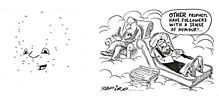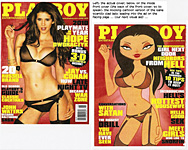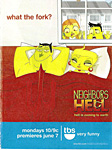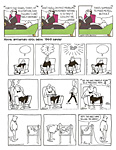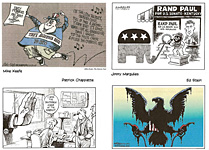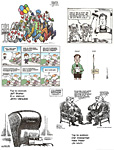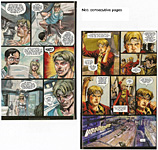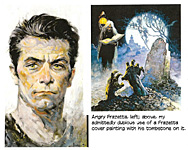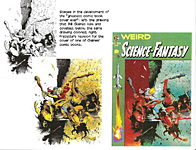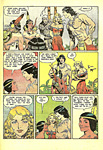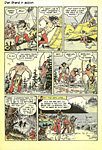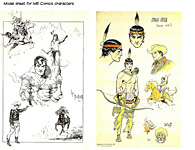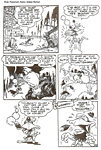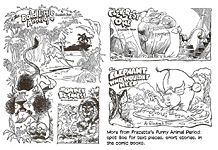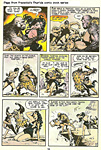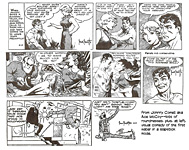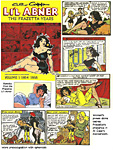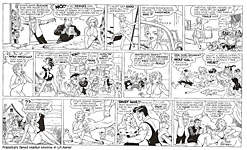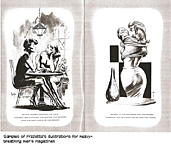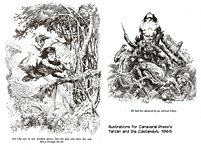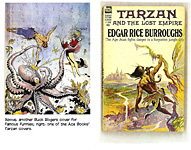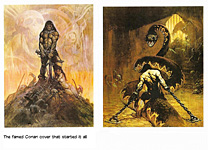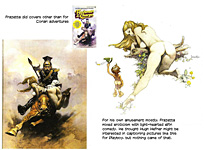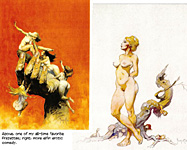 |
|||||||||||||||||||||||
Opus 262 (May 28, 2010). Everybody Draw Muhammad Day—or, as we call it here at Rancid Raves, “The Day of Effigy”—is our Big Topic in this issue: freedom of expression vs. multi-cultural sensitivity. Naturally, being the insensitive coot that I am, I joined the crusade and drew a picture of the Prophet (PBUH). Our other Big Topic is an appreciation of Frank Frazetta’s extraordinary work, both as comic book artist and as a spectacularly flamboyant painter in oil. We also ponder Arizona’s alien exclusion law, Kagan’s Kandidacy, and the impending death of Newsweek, and we review some funnybooks: The Light, Electric Ant, Killing the Cobra, Hellboy in Mexico, and Archie at the altar or not. And more, much more. Here’s what’s here, in order, by department: NOUS R US Free Comic Book Day Successes “JC” In Development at Comedy Central Pornographic Batman Manga in Trouble Wimpy Kid Sequels in Film and Print Lars Vilks Attacked, Muslim Violence & Freedom of Expression DAY OF EFFIGY More Pix of the Prophet & Worldwide Freedom of Expression The Power of the Cartoon Muslim Response to Draw Muhammad Day Little Orphan Annie Ends Bone Vilified 3-D Hooters Born Loser at 45 COMIC BOOK STORE WOES EDITOONERY Teabaggers’ Alleged Victories Arizona’s Alien Exclusion Act State Boycotted by California Unconstitutionality of the Law Dora the Explorer—Illegal Immigrant or Abused Child? KAGAN’S KANDIDACY The Froth Estate NEWSWEEK FOR SALE Time, Newsweek, U.S. News & World Report Literary Digest FUNNYBOOK FAN FARE First Issues: The Light, Electric Ant, Killing the Cobra Archie’s Deteriorating Art Hellboy Forever We’re All Brothers, and We’re Only Passin’ Through Peter O’Donnell, 1920-2010 Frank Frazetta, 1928-2010 And our customary reminder: don’t forget to activate the “Bathroom Button” by clicking on the “print friendly version” so you can print off a copy of just this installment for reading later, at your leisure while enthroned. Without further adieu, then, here we go— NOUS R US Some of All the News That Gives Us Fits FREE COMIC BOOK DAY 2010 From ICv2, we get a report on Free Comic Book Day at Captain Blue Hen Comics in Newark, Delaware, from Dave Williams: Free Comic Book Day was a success at Captain Blue Hen Comics. More than 1,400 customers came to celebrate Free Comic Book Day. Our visitors came from all over the state and from Maryland, Pennsylvania, and New Jersey to enjoy art activities, see the guest artists and characters, and to get free comics. We gave away thousands of comics to readers young and old—everyone from infants to teens to senior citizens. Visitors donated approximately 30 cubic feet of food. Our loyal customer Mike Clarke said it best, "Free Comic Book Day at Captain Blue Hen was a day for smiles." Comic book artist Jim Valentino, who was on the steering committee for the first FCBD in 2002, says: “I think it's essential that we introduce more people to the enormous talent, energy, ideas, and the wide range of subjects, genres, and approaches the field has to offer. And what better way to do that than to have an open house where everyone is invited? People who have never walked into a comic specialty store before come to it; they bring their families, and hopefully see what they're missing. I do whatever I can to promote the event,” Valentino said in a FCBD news release, “—I'm usually in at least one store during it and have been in as many as three in a single day. I think it's one of the most important days of our calendar year and I'm proud to watch it grow and develop.” FCBD was a brilliant promotion in its earliest manifestations, but I wonder if the original excitement about giveaway comic books hasn’t become a little mired in purely financial miasma. Retailers have to buy the comic books they’ll give away; and publishers must print them. Publishers justify this expense by producing special comic books manufactured expressly for the occasion, and these are not much more than brochures touting their other titles or forthcoming series. Retailers defray their costs by strictly controlling how many free comic books a customer can glom onto. Both of these maneuvers are entirely justified, but they’re also a little on the chintzy side. They suggest that the original impulses that animated the event—Valentino’s desire to introduce newcomers to the medium in some fun way—have dissipated somewhat. The happy frenzy has fizzled. A few years ago at my previous location, a comic book store gave up ordering special FCBD titles for the event. It cost too much, I was told; and the pay-off was too small. And this was a campustown store. Instead of giving away FCBD titles, the store reduced prices drastically on some surplus inventory. The bloom had gone off the rose for this store. But if you can get 1,400 customers to tramp through your store on FCBD, that’s good. And then it’s doubtless worth all the extra expense to everyone involved. At the Mile High Comics store where I do my trafficking in “newsstand comics,” the guy behind the cash register was delighted at the turn-out. As long as most store operators feel this way, FCBD forever! ***** A ROUND-UP OF ODDS & ADDENDA From ICv2: In an aggressive legal maneuver designed to protect its Superman rights, Warner Bros has filed suit against Marc Toberoff, alleging that the lawyer for the families of Superman creators Jerome Siegel and Joe Schuster had interfered with agreements between the studio and the heirs and had finagled a deal that would give him 47.5% of any rights recovered. Warner Bros’ suit alleges that the deal between Toberoff and the Superman heirs is illegal under copyright statutes. According to the New York Times, Warner’s complaint “cites a timeline of Toberoff’s attempts since 2001 to become involved with Superman.” According to the complaint, Toberoff and talent agent Ari Emmanuel (the reported inspiration for Entourage’s super agent Ari Gold) attempted to persuade the Siegel heirs to file a lawsuit against Warner Bros with the financial backing of an unnamed billionaire. The Times reports that the timeline was prepared by a lawyer who had worked for Toberoff. Toberoff, who has had some success in pursuing rights cases against the studios, is currently representing the heirs of Jack Kirby in a dispute with Marvel Entertainment, which is now a division of the Walt Disney Company. Toberoff characterized the studio’s lawsuit as “a smear campaign” and “thug tactics.” When Mark Fiore won the Pulitzer last month for his animated editoons, PBS’s “News Hour” interviewed him in his studio on May 23 for maybe ten minutes—the longest exposure an editorial cartoonist has yet received on the tube. While it is nice to think that Fiore’s overwhelming excellence prompted the attention, it’s more likely that television, a medium of “motion pictures” that lusts after anything that moves, saw his animated editoons as footage superior to anything it might have obtained had the Pulitzer winner this year drawn the traditional static, print editorial cartoons. Muhammad can't show his face around Comedy Central, but the network is developing an animated show entitled “JC,” as in “Jesus Christ,” reported Michael Cavna at ComicRiffs.com. In this new hilarity, Christ appears as a “regular guy” who moves to New York to escape the shadow of his “powerful but apathetic father.” In other words, he won’t be disguised in a bear suite, Cavna said, alluding to the “South Park” device used to satirize Muhammad in a recent outing. Concluded Cavna: “The network is again signaling that it's comfortable with satirizing some religions' prophets through cartoon, but not others.” The production company behind “JC,” Cavna adds, was also behind “The Office” and “Ugly Betty,” but, he cautions, “in general, most shows in development never made it to air.” In the propwash of box-office successful comic book superhero movies, it was
only a matter of time before the Next Thing happened. And here it is: Batman is now
starring in a porn movie from Vivid Entertainment. “Batman XXX: A Porn Parody”
spoofs the old Adam West tv show, and because it’s a lampoon (satire), Vivid and the
flick’s creator, Axel Braun, are immune from prosecution by DC Comics. Braun told Kiel
Phegley at comicbookresources.com that he went to comic conventions and visited
message boards researching the subject—“I’m very anal,” he said (I won’t touch that,
but I couldn’t let it go by unremarked)—so he’d get the costumes right. He also made a
“non-sex” version of the movie. “It's not a softcore version: there's no sex at all. It's
funny, and it's a 30-minute version with no sex. So people who are into the characters
can watch it without having to worry about the sex.” Always a big worry with comic book
fans. Braun plans a number of other similar parodies of comic book superheroes: he’s
already in preproduction on Superman, and Spider-Man and Wonder Woman will be
along soon. After that? Who knows? Green Hornet, Captain America, Thor and the
Green Lantern. “We have a bunch of them,” Braun chirped, “and they’re going to be a
lot of fun.” Takes me back to the glory days of tijuana bibles when Blondie and Popeye
and Jiggs and Tillie the Toiler and many of their consorts from the funnies were all
humping away in that routine rhythm that rocks the world, genitals on flagrant display to
the perverse delight of the parents and grandparents of today’s superhero fans. Worried about the presumed low visibility of Bugs Bunny and the rest of their
animated menagerie, Warner Bros is embarking upon an ambitious campaign to fling
them all into the spotlight, starting this fall with a new 26-episode half-hour series, “The
Looney Tunes Show,” on the Cartoon Network, and, saith the New York Times, Road
Runner and Wiley E. Coyote will soon be back in theaters in a series of 3-D shorts. ...
Amesbury, Mass., adopted hometown of Li’l Abner’s creator Al Capp, memorialized the
cartoonist during the city’s May festival by unveiling a four-piece painting featuring
Capp’s characters; installed in a “prominent place downtown,” reported the Boston
Globe, the 8-foot high series looked “like a giant comic strip.” The city is also re-naming
its millyard amphitheater after Capp. ... Pooch Café creator Paul Gilligan is taking fans
back to the very beginning for the story he’s never told: The Origin of Poncho! On
Monday, May 31, according to a syndicate press release, Gilligan will kickoff “Poncho:
Year One,” a story that begins with Poncho in utero and will follow Poncho from puppy
to young adult. The “Year One” story will take over the daily strip for the next five to six
months—and maybe longer. ... Bernard Schoenbaum, a cartoonist who managed over
25 years to get 463 cartoons published in The New Yorker, died May 7. MANGA IN TROUBLE On May 18, Brigid Alverson at publishersweekly.com reported that Viz Media had laid off about 40 percent of its total staff. Viz spokesperson Jane Lui reiterated later that the company has no plans to cancel any series or product lines, and they expect to maintain their current manga, anime, and movie release schedules and attend San Diego Comic-Con, as previously planned. But the market for Viz products is shrinking: manga sales dropped in 2009 for the second year in a row, Milton Greipp reported in his ICv2 White Paper at C2E2 in April, for a total drop of about one-third since 2007. The same day, Calvin Reid at publishersweely.com told of “another blow dealt the battered manga category”: DC Comics announced it will shut down CMX, its manga imprint, in July. “Although the initial launch of CMX generated controversy over the removal of mature material from the sexually explicit Tenjho Tenge series, the imprint went on to publish more than 50 titles since its debut in 2004. Two of the line’s most popular titles were Fred Gallagher's Megatokyo [which will continue under the DC Comics line] and the Victorian era saga, Emma by Kaoru Mori.” DC Comic co-publishers Jim Lee and Dan DiDio issued a statement: "Over the course of the last six years, CMX has brought a diverse list of titles to America and we value the books and creators that we helped introduce to a new audience. Given the challenges that manga is facing in the American marketplace, we have decided that CMX will cease publishing new titles as of July 1." SON OF ODDS & ADDENDA Aaron “Tell It Like It Is” McGruder makes sure that the N-word is liberally sprinkled throughout the animated series based upon his one-time comic strip The Boondocks, but, reported Greg Braxton at the Los Angeles Times, most other questionable language is bleeped. But now fans of the show’s heroic young black militant Huey Freeman, his little brother Riley, and his foul-mouthed cohorts can find them unexpurgated on iTunes. “Uncensored episodes of ‘The Boondocks,’ which tallied its highest ratings ever when it returned for its third season Sunday, May 2, after an absence of more than two years, will be available on iTunes 12 hours after the tamer versions air on Cartoon Network’s Adult Swim. Each episode costs $2.99, or viewers can purchase a season pass for all 15 episodes for $37.99.” Braxton added: “The season-opener, ‘It's a Black President, Huey Freeman,’ in which Huey is mysteriously depressed following the election of President Obama, scored Adult Swim's highest ratings for an original series in more than a year, attracting more than 2.5 million viewers. It also triumphed over its basic cable competition in key demographics during its 11:30 p.m. Sunday time slot.” A Brussels-based Congolese man has for years tried to get Herge’s Tintin in the
Congo pulled off the shelves on the grounds that the portrayal of Africans in the book is
racist. Bienvenu Mbutu Mondondo has been unsuccessful in pursuing the Herge
foundation Moulinsart, so now he’s started a parallel case against the book’s publisher,
Casterman, reported edmontonjournal.com. The plaintiff demands that the book be
withdrawn from sale—or, failing that, that a warning be inserted in the book to alert
readers that the portrait of Africans is not accurate. A spokesman for Casterman said:
“Casterman opposes such a withdrawal. This work was created 80 years ago, it is just a
snapshot of the sentiments of the day. It is distributed in Europe and Africa without
problem," she added. Tintin in the Congo first appeared in Belgian newspaper Le
Vingtieme Siecle as a comic strip in 1930-1931; Herge was only 23 at the time, and
he’d never been to Africa. “Before his death in 1983,” reports CBC News, “he admitted
that he regretted the negative stereotypes and attitudes in the book and in Tintin in the
Land of the Soviets.” Leo Cendrowicz, Time magazine's Brussels correspondent, said
on CBC's current affairs show, “Q,” that he expects the case will be dismissed if for no
other reason than lack of financial prowess: Mondondo is an unemployed student living
in Brussels and is up against a publishing house with huge resources. But Cendrowicz
added that the case could set a new precedent for litigation against classics written in
the past. "That is the fear of publishers, that it will open the floodgates for … literature
that is more than 50 years old. Everything written in the past was based on the morality
and ethics of the past," he said. "We can't assume the authors of the past had the
same political correctness we have today." VILKS IN THE FOOTSTEPS OF WESTERGAARD More Islamic Holligan Shenanigans Swedish artist Lars Vilks (increasingly these days called, erroneously, a cartoonist), who aroused the ire of Islamic hooligans by drawing (very badly) a picture of Muhammad with the body of a dog, was attacked on stage at Uppsala University in Sweden where he was giving a lecture on freedom of speech. The attack was prompted by his showing a portion of a film made by Iranian artist Sooreh Hera in which two naked gay men appear wearing Muhammad masks. “At that cue,” reported David Frum at cnn.com, “about 20 rowdies in the crowd shouted, ‘Stop the film! Stop the film!’ The rowdies rushed toward the stage.” One irate citizen charged up on stage and head-butted Vilks, breaking the artist’s glasses. Police extricated Vilks and restored a semblance of order with batons and pepper-spray. “After eight or so minutes of chanting, yelling and fist-pumping by the rowdies,” Frum said, “the university suspended the performance.” Reported Patrik Jonsson for csmonitor.com: “For Vilks, who has booby-trapped his own house [in self-defense] and says he sleeps with an ax beside his bed, the right to unfettered speech—regardless of whether it offends Muslims—is a point of principle.” Before showing the film, Vilks had displayed what many would have deemed offensive Christian symbols to help make his point. “What you get is a mob deciding what can be discussed at the University," Vilks told the Associated Press. “This must be carried through. You cannot allow it [free speech] to be stopped. This must be carried through. I'm ready to go up again,” he added, saying he wouldn't hesitate to try to give the address again. But university officials said they didn’t think it “likely” that Vilks would be invited for an encore, a response raising, again, concerns that violence and threats from some extremist members of the Muslim community are effectively muzzling free speech. Jonsson summarized similar events of the last month: * In response to veiled threats by a self-proclaimed Muslim group [of less than a dozen members] in New York, Comedy Central edited a "South Park" episode showing a character alleged to be Muhammad in a bear suit. *The Metropolitan Museum of Art pulled a collection of art of Muhammad to avoid offending Muslims, some of whom believe that the depiction of any of the prophets (including Moses and Jesus as well as Muhammad) is a form of idolatry. *Idiotically, Yale University Press excised the 2005 Danish newspaper cartoons depicting Muhammad in Brandeis University professor Jytte Klausen’s book, The Cartoons That Shook the World. Many, however, see the Muslim point of view. Writes Robert in Stockholm News, an English-language news site in Sweden: "Insulting people's deep-felt religious beliefs is not free speech: it's hate speech." But a chorus of others thinks otherwise: "We either have free speech or we do not. There's NO reason why any religion should be privileged, or given special immunity from 'insult.'" Many Muslims contest such assertions. Fundamental in the history of Islam was the Prophet's turning of his followers away from the idol worship that characterized Arabia in the seventh century. For this reason, for many (but not all) of the Islamic faithful, any depiction of any of the prophets—in either a positive or negative light—is strictly forbidden. Tommy De Seno, an attorney and a writer, condemned violence and threats at foxnews.com on May 4, but raised a provocative point: “I must at least consider the insult Muslims are feeling when Muhammad is drawn.” And while wondering how he might react if his religion, Christianity, were similarly insulted, he recalled the artist Andres Serrano, who, in 1987, photographed a crucifix in a bottle of his own urine and titled it "Piss Christ." De Seno also remembered New York Mayor Rudy Giuliani making news in 1999 when he cut funding to the Brooklyn Museum after it displayed a painting by Chris Ofili that depicted the “Blessed Mother Mary surrounded by pornographic images and covered in elephant dung.” A judge later reinstated the funding, but De Seno had a point to make: “As a Christian I was no less outraged by the disrespect of the symbols I revere than Muslims are when they see any depiction of Muhammad. I find an insult to religion as unnecessary in discourse as they do.” And then he asks his provocative question: why make such “works of art”? What do the folks hurling the insults get out of doing it? De Seno continues (in italics): What does it bring to the cartoonist drawing Muhammad or the painter disgracing Mary for them to do those things? I can't think of a benefit to them or anyone else when those things are done. The hurt and pain to the religious are obvious. Some will argue the non-sequitur: "They have the freedom of speech to do it." So what? With freedom comes responsibility. I'm free to say a whole wide mess of things that can insult and hurt people. I don't. I live in a society with others, and while I'm not going to curb my behavior for subjective claims over arguable insults, when something is widely understood as being hurtful to many, I'm a better person to refrain from doing it. I don't use racial epithets, and I wouldn't draw Muhammad or put Christ in a glass of urine. Why not? It would hurt others, and I gain nothing. One can criticize Islam without drawing a picture of Muhammad. One can criticize Christianity without creating horrid images of Jesus or Mary. The purpose of criticism is persuasion, and not one person has ever been persuaded by being insulted. I'm certainly not suggesting anything be outlawed. It shouldn't be. Here's what I
am suggesting: Nicely provocative, I’d say. And worth mulling over. I suspect that most of us would do as De Seno suggests—and, as a culture, we have been doing just that for several centuries—were it not for the Danish Dozen. While pondering De Seno’s suggestion, remember something that he has apparently forgotten: that the initial outbursts about pictures of Muhammad were prompted by a Danish newspaper that published cartoon images of the Prophet expressly as a reaction against Islamic hooliganism, which, with threats and violence and murder, was intimidating the press, museums, playwrights and others into muzzling themselves. The Danes’ question was: Could freedom of expression in Western culture survive such treatment? So far, it would seem, the defense of that kind of freedom hasn’t been so clarion a call throughout the land that it echoes in our behavior. And until it does, perhaps we need more pictures of Muhammad—and, even, Christ—in undignified postures. ***** Featnook. The weekend after the incident at the Uppsala University, Lars Vilks’ house was slightly damaged by Molotov cocktails lobbed at it by two brothers, aged 19 and 21, Swedish nationals of Kosovar origin, who were arrested after police found personal items near the scene. Vilks was not at home at the time. The fire blackened part of the house’s exterior and then went out by itself. DAY OF EFFIGY He Who Must Not Be Drawn (HWMNBD) Praise Be Unto Him (PBUH) Molly Norris may have disowned her Spartican protest, Everybody Draw Mohammed Day, on her Facebook page (see Opus 261 for more details), but not everyone followed her example: by the afternoon of May 20 (The Day of Effigy) thousands of images had appeared on at least two related Facebook pages, neither of which she created, together boasting upwards of 71,000 members. The postings featured “not discussion or debate but streams of verbal and visual vitriol,” saith Monica Guzman at seattlepi.com. But there’s a bright side, said Guzman: “A Facebook page against these Facebook pages had 72,000 fans by the same time.” Meanwhile, in Pakistan, a court ordered authorities to block Facebook and YouTube until May 31 so as to “spare its citizens the terrifying possibility of seeing something that might offend them,” as Nick Gillespie and Matt Welch put it at Reason. At DailyCartoonist.com, Alan Gardner says he hasn’t yet seen “reports of massive rioting or killings that were associated with the publication of the original Danish cartoons,” but there have been diplomatic incidents, he reports. The Pakistani Ambassador in Washington spoke with Special Representative Richard Holbrooke to express “the sentiments and strong feelings of the Pakistani government and people over the issue.” The embassy has also sent an official protest to the U.S. Department of State. And Pakistan filed with United Nations and the Human Rights Commission a “strong protest” against the act of so-called blasphemy. The Swedish government has closed their embassy in Pakistan “because of a threat” according to a report by the Associated Press. “The AP story doesn’t link the closure to the Draw Muhammad Day,” Gardner said, “but a report from the International News Network does make the connection.” [More likely, it was Swedish artist Lars Vilks that provoked the closure.] In India, home to the second largest Muslim population in the world, Muslims petitioned the Indian Supreme Court to ban Facebook and according to PC World, they succeeded. The abashed Norris has posted apologies, joined protest groups protesting her protest, talked with national media (“It’s been horrible,” she told Guzman), even visited, at invitation, a mosque, and gave her site a mea culpa makeover to distance herself from her monster. “And she lost 7 pounds and her comfort in artistic obscurity.” Others opposed to The Day of Effigy include several U.S. editorial cartoonists, according to Editor & Publisher. E&P quoted Chicago Tribune cartoonist Scott Stantis, who told Michael Cavna at ComicRiffs.com, that "the Draw Muhammad Day is a demonstration in the worst impulse for some editorial cartoonists." Hearst’s David Horsey agreed, and San Diego Union-Tribune cartoonist Steve Breen told Cavna, "I don't think it's kowtowing to be respectful of another's belief system." It would appear that Daryl Cagle also agrees: his website, cagle.msnbc.com, has posted no cartoons in this vein. Other cartoonists, whom Cavna didn’t name, chimed in with condemnatory phrases—shock for shock’s sake, choreographed punditry, and “wrong, childish and needlessly provocative.” Horsey and Breen are among 19 Pulitzer Prize-winning cartoonists who signed a petition to support “South Park’s” Matt Stone and Trey Parker, along with cartoonists Ted Rall, Mike Peters, Clay Bennett and Matt Davies—“none of whom planned to do a Muhammad cartoon for May 20.” One signer, however, the most recent Pulitzer winner for editooning, Mark Fiore, did an animated cartoon on the subject on Wednesday, May 19: in it, a chortling creature named Inky Al-Jihadi offers “A Jihad on Cartoonists Correspondence Course” (markfiore.com). At the National Review, Veronique de Rugy reflected on Norris’ regrets: “Isn’t the existence of the cartoonist’s fear even more reason to come up with ideas like this?” IN THE ENSUING CONFABULATIONS, several Muslims came forth to present the Islamic side of the argument. For a lengthy essay on the matter, see “A Muslim Response to Draw Muhammad Day,” which I’ve posted down the scroll after Michael Cavna’s final verdict on the episode. Most Muslim discussants, like Husna Haq, correspondent for Christian Science Monitor, offered reasoned arguments. Said Haq: “I am Muslim and I am American. I love my Prophet Muhammad, and I love my First Amendment right to free speech. To depict [Muhammad] in a bear suit or with a pig snout—as he has been in two recent cartoons—is free speech, yes, but it is intensely offensive. It betrays a willful determination to refuse to see the world through Muslims eyes—to understand how innately the Prophet is loved by his followers and how profoundly flippant disrespect for him wounds us. Imagine Martin Luther King Jr. portrayed as a monkey and you begin to understand the depth of Muslims' revulsion to such images.” After acknowledging that “South Park” and the Facebook pages are parodies,
Haq continued: “To bait Muslims so brazenly is to play into the hands of those Muslims
who often reinforce stereotypes with violent protests or threats to kill those behind the
offensive works. The situation is compounded by the fact that Muslims already feel
besieged—in some countries, literally—and humiliated.” Haq cited a recent Gallup
World Poll of some 800 million Muslims throughout the Muslim world that “reveals two
telling observations: a widespread resentment over the perceived denigration of Islam
and a belief that Westerners think Muslims are inferior. To Muslims, the Facebook
episode—and more pointedly the Danish cartoons—are proof that both are true.” The
shut-down of Facebook and YouTube in Pakistan should surprise no one, Haq said:
“The slurs can only be seen as intentionally inflammatory, deliberately designed to
humiliate a people and their beliefs—indeed, to provoke the very reaction they do.” THE DAY OF EFFIGY, they note, “has taken off like wildfire among individuals, among bloggers, tweeters, and facebookers, all of whom are perhaps a bit to quick in quoting the line, ‘I'm Spartacus!,’ an allusion to a movie in which slaves stand up to tyrants by spreading responsibility for revolt across thousands, thus making it impossible to contain.” That seems to me a perfect metaphor for what The Day of Effigy is supposed to do. Gillespie and Welch continue: “Forget the hundreds of millions of Pakistanis whose government cut off access to Facebook and YouTube in order to spare its citizens the terrifying possibility of seeing something that might offend them. Turn closer to home, to these United States. As those of us who remember the run-up to the invasion of Iraq or who still expose themselves to the obscenity of Sunday morning talk shows could tell you, our media culture has lost its nerve in the face of any threat of real and imagined disapproval from virtually any source of authority. The same outlets that were quick to cozy up to power and act as its handmaiden when it seemed propitious are similarly quick to shroud themselves in a fog of weasel words about sensitivity and prudence when it comes time to take a stand against any sort of threat.” This, it seems to me, is more like it. Had the U.S. so-called news media lived up to its obligation to inform us (by publishing the Danish Dozen that started all this—so we could see what lousy cartoons most of them were) thereby to defend freedom of speech/expression/press, we would not have to do it en masse ourselves. Remember the Danes published the cartoons as a test—to see whether freedom of speech/expression/press was vibrant enough to endure the threats and intimidation that were then afflicting life in Europe (beginning, perhaps, with the murder of a filmmaker who made a film about the treatment of women in Muslim countries). If the Danes hadn’t reacted, what might have happened later on? More murdered filmmakers? Novelists? Museum curators? Individuals in these fields had been threatened—and had reacted by surrendering to the Muslim sensibilities. Pretty soon, no more freedom of the press. No more freedom. The Danish government, incidentally, initially responded to Muslim protestors by saying that while the government could not control the press, aggrieved parties should seek legal remedies provided under the country's progressive law: "Danish legislation prohibits acts or expressions of blasphemous or discriminatory nature. The offended party may bring such acts or expressions to court, and it is for the courts to decide in individual cases." None of the aggrieved chose to avail themselves of this lawful means of redress. Instead, they continued to resort to intimidation—boycotting Danish breakfast rolls and other products of Denmark, and rampaging through the streets, destroying property and killing people. Remember, said Gillespie and Welch: “It was only a few decades ago that terrifying works such as Lady Chatterley's Lover, Lolita, Naked Lunch, and Howl could be freely published in America. For all our mythologizing about the First Amendment, which guarantees rights not only to speech but religious freedom and assembly, it is not simply a rare bird but an always endangered one too. Which is to say that Draw Mohammed Day is a sign of pushback, not by the groups you would expect to be at the forefront—the organized press and the elected guardians of the Constitution—but by a sea of individuals who will not stand by silently while forces of both hostility and accommodation collude in narrowing the space for acceptable speech. We are proud to be participants in a project that defends the core of our very slogan: Free Minds and Free Markets. Can free societies engage in speech that some may find grievously insulting, and in doing so can they advance both the debate and the ongoing liberal project? It's not just that they can, but that they must.” Reason received more than 190 cartoon-like submissions, and Gillespie and
Welch selected the one at your elbow as grand prize winner. BEFORE THAT, THOUGH, notice the other image next to Reason’s grand prize winner. This is the cartoon produced by South Africa’s most celebrated and gutsy editorial cartoonist, Jonathan Shapiro, aka Zapiro. The multi-award-winning Zapiro, you may remember, has constantly depicted Jacob Zuma, now the country’s president, with a shower spigot attached to his head as a reminder of Zuma’s comments prior to his acquittal on a rape charge that he took a shower to avoid contracting HIV. The cartoons have so enraged Zuma that he has sought hundreds of millions of pounds in damages. When the cartoon at hand was published, Zapiro’s paper, the Mail & Guardian, received a flood of phone calls, both pro and con, as well as a few death threats directed at the cartoonist. Zapiro posted a statement on his website: "Given the controversy about the Everybody Draw Muhammad Day campaign, I felt that it was necessary to draw and publish a cartoon on the subject. The objective was certainly not to offend but to draw a cartoon that was challenging. I joined the campaign because people were getting scared. It was a day of solidarity for cartoonists to draw the prophet. "I'm not completely surprised [that there was outrage],” Zapiro went on, “but I
thought my cartoon was quite gentle. I know that doesn't cut any ice with people who
want to be outraged, who want to pounce on you. The Prophet in the cartoon is asking
the therapist why other prophets have followers with a sense of humor. What he's
saying is why don't my followers have the same sense of humor and why do they react
in this over-the-top way. The cartoon is not particularly harsh—it's got an element of
pathos in it. It's almost an appeal to people to say, 'Come on, get real, get into the 21st
century.’ I am intent on expressing freedom of expression," he added. “I don't
understand why religions of various kinds should be treated differently." More adult behavior ensued over the weekend. Muslim leaders formed a committee, the United Muslim Forum of South Africa, and at a meeting on Sunday, May 23, unanimously condemned Zapiro’s cartoon as "blasphemous, insulting, insensitive, and hurtful to the Muslim community and that the publication offends the religious convictions of the community.” The Forum hoped to meet with the Mail & Guardian and would seek an apology, reported the paper’s Matthew Burbidge.. The group also resolved to embark on an education program for the media fraternity "focusing on the magnanimity of the personality of the Holy Prophet of Islam, all other prophets and Islam in general.” They also called upon all Muslims “to exercise restraint in these trying circumstances.” Elsewhere, reported the Cape Argus, the Muslim Judicial Council (MJC) has denounced death threats against Zapiro over his cartoon depicting the Prophet Muhammad, and has called on Muslims to refrain from making such threats. “MJC president Maulana Igsaan Hendricks said the organization also rejected calls for the boycott of the Mail & Guardian. While rejecting the cartoon, Hendricks called death threats against the cartoonist ‘un-Islamic,’ saying such threats had no place in the religion or society. Said he: "It only implies that Muslims lack the intellect to resolve disagreements through proper dialogue and communication, which is far from the truth." As I said, the adults have entered the room. Hendricks said MJC “respected Zapiro's right to freedom of expression, but the cartoonist had to apply this with sensitivity to religious beliefs.” By failing to do so, he said, “Zapiro has simply chosen to stoke the flames of religious sensitivity.” The MJC (which may be the same group as the aforementioned Forum; it’s hard to tell) planned to meet with the Mail & Guardian to explore options. Editor Dawes said: "I will listen carefully, and try to explain my own position. I am optimistic that the meeting will follow the pattern of robust and thoughtful debate that has characterized my conversations with Muslim jurists, community leaders, and ordinary readers in recent days.” But, he went on, “If we had to pull every Zapiro cartoon that offended someone we wouldn't have any Zapiro cartoons in the newspaper."
AS FOR MYSELF, I agree with Dawes and Zapiro and Jyette Klausen, the Brandeis University professor from whose book, The Cartoons That Shook the World, the publisher, Yale University Press, chose cowardice instead of principle and stupidly excised the 2005 Danish newspaper cartoons that the book was about. Idiotic. "When it comes to depicting the Prophet, this has nothing to do with social issues or integration," said Klausen. "This is about a political movement by sectarian groups where [depicting Muhammad] has now become a primary trigger for political contention. The Swedish university pretty much told [Vilks] to shut up and go talk somewhere else, and I find that reaction very dangerous and problematic. It means that the extremists have achieved what they wanted." Klausen is right: rampant Islamic hooliganism is polemic not religious. It is motivated by politics not theology. Each side provokes the other to further provocation; meaning is lost amid fireworks. At issue is not cultural sensitivity (or insensitivity): propaganda victories are the goal, religious faith is beside the point. Moreover, the supposed religious prohibition that supposedly inspires the protest is not supported by either history or scripture. In his booklet Muhammad: The Banned Images (48 6x9-inch pages, color; paperback, Voltaire Press; $15 from Amazon), Gary Hull recently published numerous pictures (paintings, drawings, engravings) that have depicted Muhammad from 1143 CE to 2005. Hull’s book is intended in part to refute the popularly cited notion that Muslims forbid pictures of Muhammad because they might lead to idolatry. In fact, as the book vividly demonstrates, Muslims (and non-Muslims) have been making pictures of the Prophet for centuries, most of the time without causing ire or incident. As for the origin of the prohibition: although the Koran does not specifically forbid pictures of the Prophet, many Muslims follow a tradition that regards such images as blasphemous. The Koran contains a general reference to the worshiping of idols being a “manifest error” without referring to pictures of Muhammad, but ancient oral traditions, called Hadith, quote Allah as saying it is “unjust” to “try to create the likeness of My creation” [i.e., anything in the natural world, I assume]. Islamic scholars are divided over whether it is ever permissible to depict the Prophet, but the controversies of recent years have been inspired by depictions that are mocking or disrespectful (as, ipso facto, all cartoons must perforce be). Wikipedia sheds additional light on the subject, and I quote virtually all of the rest of this diatribe from the “Mecca” entry. Fundamental in the history of Islam was the Prophet's turning of his followers away from the idol worship that characterized Arabia in the Seventh Century. For this reason, for many (but not all) of the Islamic faithful, any depiction of any of the prophets—in either a positive or negative light—is strictly forbidden. Our difficulty in the West in understanding such a view is compounded by the Muslim tradition of making a pilgrimage at least once in a lifetime to Mecca in order to parade around an ancient Arabian shrine, a low square edifice called the Ka’ba (“the cube”), which at one time housed 360 idols representing every god recognized in the Arabian peninsula, including Awf, the great bird, Hubal the Nabatean god, the three celestial goddesses Manat, al-Uzza and al-Lat, and statues of Mary and Jesus. The most important of all these deities, and chief of the Meccan pantheon, was known as Allah (meaning “the god”). Worshipped throughout southern Syria and northern Arabia, and the only deity not represented by an idol in the Ka’ba, Allah would later become the sole god of the Muslims. In 630 Muhammad took control of Mecca and destroyed the 360 pagan idols, with the notable exception of the statues of Mary and Jesus. Muhammad did not, however, destroy the Ka’ba and the sacred stone it housed. Rather, he made them a centerpiece of the Muslim religion. The Hajj pilgrimage to Mecca is the fifth of the fundamental Muslim practices known as the Five Pillars of Islam. Entering the great Mosque in Mecca, the pilgrim first walks seven times around the Ka’ba shrine in a counterclockwise direction; this ritual is called turning, or tawaf. Next, entering into the shrine, the pilgrim kisses the sacred stone. Sounds like idol worship to me, but then, so does kneeling before a cross in a Christian sanctuary. But that’s enough blasphemy for one day. THE POWER OF THE EDITORIAL CARTOON endures, saith Michael Cavna at ComicRiffs.com. On May 21, he found much to rejoice over in the never-ending brouhaha about HWMNBD/PBUH, writing: “The ability of a single sketched image to provoke, prompt, incite, summon or inflame—a virility and virality sometimes questioned in a new-media age—is intact. Whether deemed to have been drawn nobly or irresponsibility, to enlighten or enrage, the cartoon that touches that precise nerve—whether purposefully or accidentally—still can quickly inflame an entire body of thought or an entire body politic. “If that sounds like an obvious, natural-born conclusion the day after Everybody
Draw Muhammad Day, the week after a Swedish cartoonist was attacked and his home
was literally inflamed, the month after "South Park" animation sparked postings of Theo
Van Gogh images, then perhaps you haven't been paying attention to those stretches
when the political cartoonist is declared a dying profession and the newspaper
cartoonist's format a relic of an inkier era. ... Thanks to new media, especially, the
power of the cartoon remains enhanced.” A MUSLIN RESPONSE TO DRAW MUHAMMAD DAY PRNewswire-USNewswire The Council on American-Islamic Relations (CAIR) today offered what the Washington-based civil rights and advocacy group called "A Muslim Response to 'Draw Muhammad Day" by CAIR’s national executive director, Nihad Awad. It follows in italics (with only modest editing to remove matters already outlined in the foregoing): I will be the first to defend anyone's right to express their opinion, no matter how offensive it may be to me. Our nation has prospered because Americans value and respect diversity. But freedom of expression does not create an obligation to offend or to show disrespect to the religious beliefs or revered figures of others. ... Despite the Facebook page creator's seemingly sincere attempts to distance herself from the fake event, Muslim-bashers and Islamophobes made sure the call to "draw Muhammad" went viral on the Internet. They are hoping to offend Muslims, who are generally sensitive to created images of the Prophet Muhammad or any prophet. [The majority of Muslims believe visual representations of all prophets are inappropriate in that they distract from God's message and could lead to a kind of idol worship, something forbidden in Islam.] So how should Muslims and other Americans react to this latest attempt by hate-mongers to exploit the precious right of free speech and turn May 20 into a celebration of degradation and xenophobia? Before I answer that question, it must first be made clear that American Muslims value freedom of speech and have no desire to inhibit the creative instincts of cartoonists, comedians or anyone else. The mainstream American Muslim community, including my own organization, has also strongly repudiated the few members of an extremist fringe group who appeared to threaten the creators of "South Park." That group, the origins and makeup of which has been questioned by many Muslims, has absolutely no credibility within the American Muslim community. I, like many Muslims, was astonished to see media outlets broadcasting the views of a few marginal individuals, while ignoring the hundreds of mosques and Muslim institutions that have representatives who could have offered a mainstream perspective. Next, one must examine how the Prophet Muhammad himself reacted to personal insults. Islamic traditions include a number of instances in which the Prophet had the opportunity to retaliate against those who abused him, but refrained from doing so. He said, "You do not do evil to those who do evil to you, but you deal with them with forgiveness and kindness." Even when the Prophet was in a position of power, he chose the path of kindness and mercy. When he returned to Mecca after years of exile and personal attacks, he did not take revenge on the people who had reviled him and abused and tortured his followers, but instead offered a general amnesty. In the Quran, Islam's revealed text, God states: "Invite (all) to the way of your Lord with wisdom and beautiful preaching, and argue with them in ways that are best and most gracious: for your Lord knows best who have strayed from His Path and who receive guidance." (16:125) This is the guidance Muslims should follow as they express concern about an insulting depiction of the Prophet Muhammad, or of any other prophet of God. Instead of reacting negatively to the bigoted call to support "Draw Muhammad Day," American Muslims—and Muslims worldwide—should use that and every other day as an opportunity to reach out to people of other faiths and beliefs to build bridges of understanding and respect. The best and most productive response to bigoted campaigns like "Draw Muhammad Day" is more communication, not less communication— including not restricting the free flow of ideas with measures like banning Facebook. Research has shown that anti-Islam prejudice goes down when people interact with ordinary Muslims and have greater knowledge of Islam. Therefore, the best reaction to those who would mock the Prophet Muhammad (or the religious symbols of any faith) might be a mosque open house for the local interfaith community, a community service activity organized by Muslims and involving people of other faiths, or a newspaper commentary describing the life, legacy and personal character of the Prophet Muhammad, which is the opposite of the calumny some people fabricate about him. This should be of concern to all decent and objective people. We will all benefit if each of us—whether Muslim, Jew, Christian, Buddhist, or Hindu—exhibits the common human decency required by our respective faiths. ***** Somali-born rights icon Ayaan Hirsi Ali received a free speech award last month from Jyllands-Posten, the Danish newspaper that sparked Islamic outrage by publishing
those cartoons of the Prophet Muhammad in 2005. "The committee did not doubt for an
instant that you deserved this award for your unshakeable faith that it was worth fighting
for your points of view," editor Joern Mikkelsen said at the award ceremony in
Copenhagen, reported by Agence France-Presse. CLIPS AND QUOTES “Historically, the claim of consensus has been the first refuge of scoundrels: it is a way to avoid debate by claiming that the matter is already settled.”—Michael Crichton “Everybody gets so much information all day long that they lose their common sense.”—Gertrude Stein, who oughta know “The biggest big business in America is not steel, automobiles, or television. It is the manufacture, refinement, and distribution of anxiety.”—Eric Sevareid, journalist “There’s no such thing as originality anyway—just authenticity.”—17-year-old German wunderkind Helene Hegermann upon being accused to plagiarizing parts of her acclaimed debut novel, Axolotl Roadkill.
ARF ARF SOME MORE On May 13, 2010, Tribune Media Services announced its intention to stop production and distribution of one of cartooning’s iconic creations, the newspaper comic strip Little Orphan Annie. The resilient redheaded teenager is scheduled to make her last appearance in the nation’s newspapers on Sunday, June 13, just two months shy of celebrating an 86-year run. But the longevity, while notable, is deceptive: the strip foundered badly after the death of its creator, Harold Gray, in 1968, and while one of Gray’s successors righted the craft for two decades, Annie never again achieved the circulation or cultural status it enjoyed in Gray’s hands, proving yet again that a comic strip, uniquely the product of individual inspiration, usually cannot survive the death of its creator. And Gray’s strip was more idiosyncratic than most, a proposition we attempted to prove with our last posting (May 17) to Harv’s Hindsight, where we reviewed the history and appreciated the artistry of Gray’s magnum opus. (If you missed it, no matter: it’s still there; go visit.) Immediately upon receiving the announcement about the impending cessation, Michael Cavna at ComicRiffs phoned Steve Tippie, the syndicate’s licensing vp, for more details. The decision to end the strip was not arrived at lightly, Tippie insisted, and it involved a number of factors. One was sheer expense. Said Tippie: “We want to pay the creators a decent wage for the work they do. And Ted Slampyak and Jay Meador did terrific work—some of the best in the story strip line. That need combined with the production costs of getting a strip distributed just crossed the profit-loss curve this year.” But the syndicate, Tribune Media Services (TMS), also had an eye on future deployment of the feature. If it stopped pouring money into a strip that, with less than 20 client newspapers, could no longer make a profit for anyone, it could start scanning the horizon for other revenue-producing possibilities with the franchise. “We felt that Annie, unlike many strips, has such wide, almost iconic presence in our culture that it would serve the character and our business best if we focused on other channels more appropriate to the ‘kids’ nature of the property,” Tippie said, willfully ignoring the historic role of newspaper comic strips as adult material. And TMS has its corporate eye on licensing Annie. TMS owns all licensing and production rights to the Annie characters, trademarks and copyrights. “What we do not own,” Tippe said, “but participate financially in as a licensor, is the ‘Annie’ musical and its songs. But the musical creators license the property from us.” Tippie doesn’t see much chance that Annie will someday return as a print newspaper comic strip, but he doesn’t discount the possibility altogether: “It depends on how newspapers refashion themselves over the next few years. Not terribly likely, but nothing is out of the realm of possibility.” But the emerging electronic environment offers considerable potential to “a sequential visual story-telling property in mobile, eReader/iPad and other yet-to-be conceived electronic channels. I would pump up the probability considerably that we'll see new products. If the right people with the right vision apply themselves to the property,” he went on, “the sky's the limit. Annie itself is a good example. In the late 70s, new production of the strip had ended and we were running ‘classic reprints.’ Then the musical refashioned the property and gave us another 30 years of original Annie in print.” He continued expounding on the possibilities: “Just like I firmly believe that there will always be a need and desire for the things that newspapers do (even if the format and delivery vehicle change), I think that there will also always be a need and desire for the way stories are told visually and sequentially as they are in the classic and contemporary comic strips.”
**** Fitnoot: I forgot to mention in that Hindsight about Little Orphan Annie what is perhaps the most unique feature of the strip—that is, the narrative is not continuous: it’s consecutive. Today’s strip is about what happened today; tomorrow’s strip is what happened tomorrow. What happened in yesterday’s strip is referred to in today’s strip as something that happened yesterday—not just a few minutes or hours ago. The strip, in short, is much like a diary: it records the chief happening in the ageless orphan’s life on a given day and only on that day. Perhaps Gray could not get his mind around the notion that what is happening in today’s strip could continue happening tomorrow and tomorrow and tomorrow, creating a continuity of action. That, to Gray, would be unrealistic. His hang-up about how to depict reality created certain problems for him. If Annie has a fight in today’s strip, by tomorrow’s strip, the fight is over: in tomorrow’s strip, the fight was in yesterday’s strip. Big, time-consuming actions had to take place on Sunday, when the strip afforded Gray enough room (time) to depict complicated action. Gray’s reputation as a propagandist for conservative values was formidably established by Annie’s self-reliance during the Depression in the 1930s (and, more famously, in 1944 when Gray killed off Daddy Warbucks because the self-made millionaire couldn’t stand living in the welfare state of Franklin D. Roosevelt), but the cartoonist didn’t see himself as grinding an axe in the strip. In an interview in Editor & Publisher in 1951, Gray said: “God deliver me from a reformer, even an honest one. I dislike preaching, and missionaries of any kind. I don’t mean religious missionaries exclusively. They are bad enough. Worse, in my opinion are communistic, evangelists or evangelists of democracy or the capitalistic system. Why can’t we leave each other alone? Butting into the other fellow’s business is a prime cause of trouble, misery, and war. There are eternal verities easy enough for all to learn: tell the truth, work hard, save your money to be independent; in short, ‘keep your nose tidy!’ And that’s enough.” Gray had a high opinion of newspaper reporters and saw himself as one of the breed. “Like reporters,” he said, “I try to be objective, to write and draw things as they are. Oh, I glorify a little once in a while, perhaps. Sometimes my gangsters have hearts of gold. But I have crooked politician and honest ones, snobs, wastrels, gamblers, kind-hearted and cruel people, foolish and wise all living and fighting together, usually in a small town.” To keep his strip’s realistic aura, Gray and his wife traveled the country frequently, stopping in small towns to talk to people, to find out what they are thinking and feeling. The cartoonist reportedly thought of himself as “gregarious, not a party-going man, but a guy who likes people and likes to talk with them.” Everyone, perhaps, but Franklin Roosevelt. BONE VILIFIED When Alverson asked Smith about it, he laughed. “I'm laughing,” he said,
“because it doesn't seem like you could really find those things.” All the characters in Bone are adults, he said, and he acknowledged that some of them, the more unsavory
ones, “will try to pull gambling scams, try to rig bets and things, and it always goes
wrong. So no one is rewarded for doing any unsavory behavior in Bone, and it's difficult
for me to see how anyone could think Bone would encourage kids to do unsavory
things. Also, none of the main characters do these things. My conclusion is that some
people aren't smart enough to read comic books.” In a letter to the school board that he posted on his blog, Smith said that while
beer and gambling are depicted in Bone, they’re only story devices and play “a very
small role in the overall Bone story. As far as sexual situations between characters are
concerned,” he continued, “I know of none. Nor was it ever my intention for there to be
any. The main character Fone Bone has a crush on the young woman Thorn, but it's
innocent, and certainly goes no further than holding hands. ... Since the mid 90's,
millions of parents all over the world have read Bone with their children. This is the first
time I have ever heard it suggested that it was age inappropriate. It is hard to imagine
that any bad behavior could be seen to be encouraged in these stories. Frankly, I
believe it is just the opposite." 3-D HOOTERS In the June issue, Playboy, as it does every year in the June issue, unveils its Playmate of the Year (or PMOY, as the magazine sometimes terms it), and this year the undraping is enhanced by a gatefold pinup of the woman, Hope Dworaczyk, in 3-D—“our first ever!” exclaims Playboy. And you get a pair of the cardboard glasses with a red and a green lens to enable you to view the woman’s voluptuousness in what promises to be a life-like illusion. Alas, it doesn’t quite work. Hope herself is quoted on the matter in Time: “It’s kind of like it says on the rearview mirror: things may appear larger.” Well, no, actually. The illusion fostered by 3-D stunts of this sort typically gives a two-dimensional picture depth, not greater size. And in this case, Hope, standing in black garter belt, hose, and heels and not much else, is holding a glass of wine out towards us in a toasting gesture—and that, the hand and arm and glass of wine, seems to stand out from the picture in a third dimension. That much works, but it works, in the typical fashion of 3-D pictures, because the pose creates a visual situation with inherent depth. Hope’s boobs, on the other hand, are seen from the side, which doesn’t give them any inherent depth. Maybe she seems rounder, but I’m such a visual person that I usually see roundness in barenekkidwimmin whether I’m using red and green lenses or not. While we’re paused here at Playboy, take a look at a pair of covers: on the left, a photo of the actual PMOY Hope; on the right, the same cover as a cartoon rendering. The latter appeared in the magazine as the inside front cover, a parody on the “back” of the real cover—just conveniently, strategically, opposite the first page in the magazine, which advertised, as we see in our next visual aid, a new slightly-more-than-risque cable-tv series, “Neighbors from Hell.” Is that a three-pronged erection in the foreground of the ad?
A LOSING RECORD The Born Loser celebrated its 45th year on May 15 even though it was May 10 that the strip debuted in 1965. Art Sansom, the originator of the feature, had been producing artwork and sometimes realistically rendered comic strips for NEA since joining the syndicate staff as an illustrator in 1945. Among the early strips he collaborated on were Peggy, Chris Welkin - Planeteer, and Vic Flint - Private Investigator. After twenty years drawing others’ creations, he concocted his own strip about hapless Brutus Thornapple, the loser who was apparently born to arrive missing whenever a ship docks. Art died July 4, 1991, and the strip has been continued since then by his son, Chip, who was merely 14 when his father invented Brutus and his wife Gladys, his Scrooge-like boss Rancid Veeblefester, the wonderfully named panhandler Wastrel P. Gravesite, and numerous others, all of whom fare better than Brutus on a day-to-day basis. Chip had been helping his father for years. He first tried the business world after graduating from Case Western Reserve University with an applicable degree in about 1973, but after four or five years, he said, “I discovered I couldn’t stand it. At the time, my father was looking for an assistant.” Father and son shared drawing and gag-writing chores. They started each week with a Monday morning gag-writing session. As Art remembered it for an article about the strip’s 25th anniversary: “We’ll sit down and toss around the best 15-20 gags we can come up with, back and forth, then narrow that down to the best seven.” But gag-writing goes on all the time, day after day, no matter where the cartoonists might be. Said Art: “Inspiration can strike at the most inopportune times. I’ve discovered that a good way to clear out an elevator is to start chuckling to yourself.” In 1981, Art and Chip teamed up on a humorous strip about life on a Texas dude ranch with the title character, Dusty Chaps, a country western singer patterned somewhat after the Urban Cowboy fad. But this effort, more realistically (albeit still simply) drawn than the Loser, didn’t last long. These days, Brutus and his ensemble cast circulate to more than 1,300 newspapers in 35 countries, and Chip signs the strip with both his name and his father’s. “I am very happy that The Born Loser is still as appealing to readers, new and old, as it was when it first appeared 45 years ago,” Chip said in the syndicate press release. “It is a tribute to the great characters my dad created and his universal and timeless premise that Brutus Thornapple is an everyman, taking the fall for the rest of us in the trials and tribulations we face everyday.” The strip continues to be a family affair with Chip’s wife, Brooke, assisting him in much the same way as when he started working for his father. Daughters Jacqueline and Isabel are a constant source of material for the strip. Appropriately, Chip now works in his father’s old studio in the Sansom family home in Lakewood, Ohio. Here’s the anniversary strip (in color) with samples of the strip for 1969, when Art
Sansom was still doing it solo, the drawings rendered in a rather more languid manner
than later on. The earlier strips are nifty examples of deploying the visual resources of
the medium for a gag. Fascinating Footnit. Much of the news retailed in the foregoing segment is culled from articles eventually indexed at rpi.edu/~bulloj/comxbib.html, the Comics Research Bibliography, maintained by Michael Rhode and John Bullough, which covers comic books, comic strips, animation, caricature, cartoons, bandes dessinees and related topics. It also provides links to numerous other sites that delve deeply into cartooning topics. Three other sites laden with cartooning news and lore are Mark Evanier’s povonline.com, Alan Gardner’s DailyCartoonist.com, and Tom Spurgeon’s comicsreporter.com. And then there’s Mike Rhode’s ComicsDC blog, comicsdc.blogspot.com and Michael Cavna at voices.washingtonpost.com./comic-riffs . For delving into the history of our beloved medium, you can’t go wrong by visiting Allan Holtz’s strippersguide.blogspot.com, where Allan regularly posts rare findings from his forays into the vast reaches of newspaper microfilm files hither and yon. QUOTES AND MOTS “When CEOs are making more in ten minutes than the average worker earns in a year and millions of families lose their homes due to unscrupulous lending, checked neither by a sense of corporate ethics or a vigilant government; when the dream of entering the middle class and staying there is fading for young people in our community, we have more work to do.”—Barack Obama, July 2008 “People who see a drawing in The New Yorker will think automatically that it’s funny because it is a cartoon. If they see it in a museum, they think it is artistic, and if they find it in a fortune cookie, they think it’s a prediction. ... I try to make them jittery by giving them situations that are out of context and contain several interpretations.”—Saul Steinberg “I didn’t call it a graphic novel. I called it a novel in cartoons. Graphic novels are called graphic novels because people are ashamed of the term ‘cartoon,’ which is idiotic. I’ve always been thrilled to be a cartoonist, and I’m proud of it, and like the term. I see no need to upscale the work I do with some meaningless choice of words like ’graphic.’”—Jules Feiffer on his book, Tantrum “I was going to give a graduation speech in Arizona this weekend, but with my accent, I was afraid they would try to deport me.” —Arnold Schwarzenegger Asked why a Brillo box is a piece of art in a museum and just a product in a supemarket, David Dadone, director of the Boulder Museum of Contemporary Art, said: “It is about the ideas that are behind the Brillo box. I knew an artist, she had a piece that was just a banana peel on the floor. The security guy at the gallery had to come in every morning and peel a banana and throw the peel on the floor. It’s just an idea. Art is getting more conceptual every day. Everything can be art.” COMIC BOOK STORE WOES: PART THREE Ben Davis, owner of Big Ben’s Comix Oasis in downtown Allen Park (near Dearborn, Michigan), says 40% of his revenue now comes through Internet orders rather than store sales. Interviewed by Michael Hicks for Press & Guide Newspapers, Davis said: “If we were just dependent on our Michigan base, it’d be scary. We didn’t have to sell to anybody else six or seven years ago.” Adult collectors are his customer base these days, not kids caught up in the mythos of superhero fantasies. Back issues and collectibles pay the bills, he told Hicks. The stalled economy has had an impact. Davis, who had operated his store in four different locations in 26 years, said he’s lost customers who have been laid-off and can no longer afford their hobby. “We had a nice clientele of Ford guys who just can’t do it no more,” Davis said. “I had one Ford guy who was spending probably $50,000 a year in here, then woke up one day and found out he’s out of a job.” But the sluggish economy isn’t the only culprit. Davis’ big concern is that he doesn’t see kids buying comic books anymore. Said Hicks: “Over the last few years, national print runs of comic book issues have shrunk dramatically, according to Davis. Titles that once had a million copies printed for each issue have been reduced to around 100,000. The decline in young readership and the economic troubles of both adult consumers and the comic book industry have changed his outlook on conducting business in a niche market.” Davis talks to other comic book store owners every day: “It’s all about how we can keep the interest going. There are people out there who will buy this stuff but how do we get these people back in to guy the stuff?” Camaraderie has replaced competition, concludes Hicks. (Big Rancid Raves THANQUES to field agent Ed Black for sending the clipping.) EDITOONERY Afflicting the Comfortable and Comforting the Afflicted The oil spill in the Gulf and the results of the primary on May 18 seem to have absorbed
just about all the attention we can reasonably devote to current events. Ditto editorial
cartoonists. Some of the more provocative cartoons on these issues we’ve arrayed
nearby. Rand Paul’s victory in Kentucky was regarded as a triumph for the Teabaggers—as was Arlen Specter’s loss in Pennsylvania. But as Mike Keefe suggests, the Teabaggers’ winning slogan, “Take Our Country/Government Back,” seems to put us on a road to 1954. At that time, Americans with disabilities could almost never gain access to public buildings and Woolworth’s could still segregate its lunch counters. Paul’s harping on the Teabagger theme backed him into just that racial corner, and while he told MSNBC’s Rachel Maddow that he thinks all discrimination is abhorrent, the government should not be permitted to interfere with private business in order to enforce such otherwise laudable legislation as the Civil Rights Act of 1964. The “market,” he believes, should be permitted to effect such changes. But, as Mike Littwin at the Denver Post pointed out, “in the Jim Crow South, the market didn’t take care of anything until the government finally stepped in.” Paul, however—Jimmy Margulies vividly reminds us—apparently wants to “take the country back” to exactly the time of Jim Crow South. Ed Stein’s comment on the oil spill is nicely, dramatically, messy, implying that filling your gas tank can have oily consequences, and Patrick Chappatte’s note on federal regulation of banksters is impressive imagery. A good crop for the week. The Grinning Old Pachyderm rejoiced roundly at the results of the May primary, but many commentators found less for the GOP to be happy about. Paul’s Teabagger win overshadowed Democrat Mark Critz’s victory over Republican Tim Burns in a Pennsylvania district that had voted for John McCain in 2008, and Paul’s heralded triumph was actually a severe setback for the GOP. His opponent, whom he overwhelmingly beat, was the pick of Senate Minority Leader Mitch McConnell, a stalwart Republican Kentucky senator, and was, therefore, a resounding rejection of the Republican Establishment in both Kentucky and in Washington. In short, Paul’s resplendent fate ought to remind the Aged Elephant that Teabaggers are against “Washington,” Republicans as well as Democrats. As for Specter’s loss, it was, as is Specter himself, neither a Republican nor a Democrat loss: it is the loss of another Establishment pol (the first count against him) who’d memorably demonstrated his willingness to switch political allegiance in order to save his job (fecklessness being a second count against him) but ran up against a younger, much more attractive personality (count three, you’re out). The body politic’s ardor for the Democrat Party may have cooled, as syndicated columnist Eugene Robinson said, but that “has not led to a passionate embrace of the GOP. There’s a splash-back effect from [the Teabaggers’] unceasing attacks against the evil empire known as Washington: voters notice that Republicans live there, too.” Arizona puts the AZ in nAZi You might think editoonist Jimmy Margulies went a little too far in his deployment of
symbolic imagery in the cartoon in this vicinity, but even if you agree with the Anti-Defamation League’s Abraham Foxman that the cartoon trivializes the Holocaust, I
think you must admit that giving Adolph Hitler’s famous moustache the shape of the
state of Arizona makes a powerful statement about the potentially fascist effect of the
state’s new immigration law. With that law, as Michael Cavna observed at his ComicRiffs blog, “Arizona puts the AZ in nAZi.” That’s a pretty symbolic typographical maneuver itself. What Margulies did in his cartoon makes telling use of the medium’s capacity for conveying a message succinctly, and therefore dramatically with impact, by means of a visual metaphor. Nicely done. Foxman has another point of view, expressed in a press release from ADL: "We are seeing these offensive and inappropriate Nazi and Holocaust comparisons come to the fore in the public debate once again. We saw it in the health care debate, and now we are seeing it with Arizona. It is disturbing that in speaking out against the bill a number of individuals have taken to using Nazi comparisons, in describing the legislation as being reminiscent of Nazi policies that required Jews and others to carry identity cards, or in comparing the governor and other Arizona officials as being like Hitler.” Foxman said it might be "politically expedient" to invoke such symbols, but “no matter how odious, bigoted, biased and unconstitutional Arizona's new law may be, let's be clear that there is no comparison between the situation facing immigrants, legal or illegal, in Arizona and what happened in the Holocaust." Then he referred specifically to Margulies’ cartoon. It’s Foxman’s job as director of the ADL to keep our feet to the fire on matters that pertain to irrational discrimination and groundless stereotyping and mindless racism, but I doubt the Holocaust can be trivialized, as he seems to fear. It can be denied by fabulists and other specialists in alternative realities, but it cannot be trivialized. Cavna interviewed Margulies on April 29, and Margulies explained—“and reinforced”—the Nazi analogy, “stating that it was appropriate to tap not only its potency, but also its literal memory”: "As a Jew of Eastern European descent,” Margulies said, “ I am well aware of the unique horror of the Nazi era. It is all the more important that I, and others of good conscience who are able to reach an audience, do so in the face of abhorrent laws such as Arizona's. I do not think it diminishes the memory of the Holocaust to point out that the law in Arizona is uncomfortably reminiscent of Germany's in targeting one or more minorities. Before the concentration camps, there were smaller measures enacted which set the stage for greater acts. The Arizona law gives police too much power by casting as suspects anyone who looks to be Latino or foreign-born." Exactly. One thing leads to another. Some objectors to the Arizona law see it as specifically empowering police to ask for citizenship papers from anyone they think looks suspicious. While the law doesn’t do that (cops can ask for papers only of those who seem to have committed some infraction of a law), it opens the door to such practices: it seems the thin edge of a wedge that could conceivably lead to practices much more invasive—much more fascistic. One thing leads to another. Hitler became chancellor of Germany on January 30, 1933, and he moved at once to begin shoring up his power. The concentration camp at Dachau opened on March 20, and by the end of the year, 49 other such camps were operating throughout German. Communists and Socialists, those in the political parties opposed to Hitler’s National Socialists (Nazis), were among the first occupants of these camps. Jews, gypsies, the handicapped, homosexuals, Jehovah’s Witnesses and other political and religious dissidents soon joined the Communists and Socialists. By July all political parties other than Hitler’s were outlawed. On May 10—just 100 days after Hitler assumed power—hundreds of thousands of books were burned all over Germany as libraries and bookstores were “purged” of “un-German” writings. The bonfires were accompanied by torchlight parades and speeches that advocated the death of “Jewish intellectualism” and the consequent “purification” of German culture. The works of such Jewish intellectuals as Albert Einstein and Sigmund Freud fueled the fires, as did the books of Heinrich Heine, a German poet of Jewish origin. A century earlier, Heine had written: “Where books are burned, in the end people will be burned.” One thing leads to another. And one of the beginnings was the appointment of Hitler as chancellor by the aged President Paul von Hindeburg, who thought Hitler, as the leader of Germany’s largest political party, could restore order in the country ridden by social unrest, economic dislocation, and bitter resentment over the terms of Germany’s surrender in World War I. Hitler did restore order—the order of dictatorship, absolute and unyielding. “Family Guy” creator Seth MacFarlane has also compared Arizona's actions to Hitler's Germany, according to Reuters, cited by Cavna a couple weeks ago. During a Reuters tv interview, MacFarlane said the Arizona law was more shocking than his own irreverent, hot-button tv shows, “American Dad” and “The Cleveland Show”(not to overlook the equally outrageous “Family Guy”). “It’s too much,” MacFarlane said. “It’s kind of a slap in the face; it's not the way to handle it [i.e., illegal immigration]. Nobody but the Nazis ever asked anybody for their papers.” MacFarlane then perpetuated the erroneous interpretation of the law: "Walking down the street, a cop can come up to you and say, 'May I see your papers?'” But MacFarlane gave it a twist that gave his misconception a satiric bite: “I think they should be required to ask that question in German if the law sticks around." Name calling, however apt, and symbol mongering, however imaginative, are scarcely useful substitutes for rational political discourse and reasoned debate. But Margulies’ cartoon is nonetheless a model of its medium, a remarkably effective example of the best uses of the resources of the cartoonist’s art in the single-panel editorial cartoon. **** AS ARIZONA STARTS INSTRUCTING its law enforcement agencies on the ways to apply the new law, outrage flourishes in other states. In Colorado, schools have decided not to take athletic teams to Arizona for scheduled competitions for fear the players, some of whom might have brown skins, might be asked for citizenship papers. In California, Governator Ahhhnold threatened to boycott Arizona products, and Los Angeles, Oakland, and San Francisco have passed resolutions directing city staff to consider which contracts with Arizona can be terminated. In the same spirit of joyful vengeance and general hullabaloo, the Arizona utility commissioner said he’ll ask the state’s utility companies to cut off the power supply to Los Angeles, which gets about 25 percent of its power from Arizona. All of this fervid brouhaha is another of the civic distractions to which we are repeatedly being subjected as the news media, feasting on the sensational, neglects to tell us what we need to know. In this case, if we knew it, there’d be no sensation, and the alleged news media would lose the “story” that’s attracting viewers and readers. What we should know: Arizona’s law is unconstitutional. On numerous occasions in the past, the U.S. Supreme Court, facing kindred crises, has always ruled that Congress has the exclusive authority to regulate immigration. Immigration is a federal matter. States can’t do it. Cities can’t do it. Arizona can’t do it. Ergo, the entire Arizona edifice of alien exclusion will shortly collapse in a federal court. In the meantime, of course, the news media will have a field day interviewing right-wing demagogues, who will join enthusiastically in the sport, hoping, in these tea-bagging times, their bloviating will get them re-elected. The unconstitutionality of the Arizona law is also founded on its violation of the 14th Amendment: “Nor shall any state deprive any person of life, liberty or property without due process of law; nor deny to any person within its jurisdiction the equal protection of the laws.” Singling out persons “suspected” of being illegal aliens deprives them of equal protection. Note the 14th Amendment is not exclusive to American citizens: “any person” is the language. The question of how to interpret the “equal protection” clause of the 14th amendment has effectively been the history of that amendment, according to Wikipedia, which presents what seems to be the whole of that history. The short of it, though, as it applies to today, seems to begin with John Marshall Harlan who dissented in the infamous Plessey case (1896) that segregated buses and passenger trains (among other things) based upon race, saying: “[I]n view of the Constitution, in the eye of the law, there is in this country no superior, dominant, ruling class of citizens. There is no caste here. Our Constitution is color-blind, and neither knows nor tolerates classes among citizens.” Such “arbitrary separation” by race, Harlan concluded, was “a badge of servitude wholly inconsistent with the civil freedom and the equality before the law established by the Constitution.” Since Brown v. Board of Education (1954), Justice Harlan’s dissent in Plessy has
been vindicated as a matter of legal doctrine [Wikipedia continues], and the clause has
been interpreted as imposing a general restraint on the government’s power to
discriminate against people based on their membership in certain classes, including
those based on race and sex. In Arizona, they’ve taken particular pains to “narrowly tailor” the law to serve a
“compelling” interest. But that will give lawyers something to argue over. ***** BESIDES—just to heap up the case against the Arizona legislature and all who cheer it on—the new law could lead to an increase in violent crime. The officers of the law in any state are a fairly small population relative to the rest of the citizenry. “We can’t be everywhere,” said a deputy sheriff interviewed by Denver Post columnist Ed Quillen. “If we’re going to maintain any kind of public order,” the deputy continued, “we need people to report crimes, and we have to find witnesses and get them to talk and maybe testify in court.” And then he posed the Real Question about citizens in communities where lots of immigrants (legal as well as illegal) live: If somebody is robbed, is he or she going to report the theft if he or she thinks the police will check his papers and deport him if he doesn’t have the right ones? If cops are supposed to check papers, the deputy went on, “word would get out pretty fast. Nobody would report any crime, maybe not even murder. So you’d have this enclave of total lawlessness.” And the outlaws would pretty soon extend their operations beyond the enclave into the general population. “They’d be hitting us gringos, too,” the deputy said. “Swipe a car, get it back to the chop shop in the barrio, nobody will talk, and it could get a lot worse than that. So there are some real practical reasons for cops not to care about immigration status.” So that, Quillen concludes, explains why Arizona’s proposed immigration crackdown could lead to an increase in violent crime, although it might not be reflected in the official statistics. ***** DORA THE EXPLORER—Poster Child for Immigration. Is she extolling the benefits of Arizona’s new would-be law or exemplifying its grim unintended consequences? It’s impossible to know which unless all you do is look at the picture: Since 1999, the ambiguously Latina cartoon heroine of a Nickelodeon tv show has been teaching children the English alphabet, colors and Spanish phrases, explained Sophia Tareen at the Associated Press. Now her image has been appropriated in the illegal immigration crusade and is being used at rallies and websites on both sides of the argument about the Arizona law. So she is either an example of what supporters of the legislation might wish on immigrants; or of what opponents say might happen to immigrants if the law is enforced. Whichever her use in the campaign, however, the picture depicts the victim of child abuse, an image terrifying to young viewers of the tv show (not that any of them would ever see the beat-up Dora), not to mention being a clear instance of the abuse of a children’s tv show. The accompanying image was designed by Debbie Groben as an entry in a contest sponsored by the fake news website Freakingnews.com. Groben, although opposed to the Arizona law, told Emily Friedman at abcnews.go.com that her version of Dora has “nothing to do with illegal immigration: it was done in fun,” a position that I find extremely hard to believe given the sign Dora is holding under her chin while being photographed for a police mug shot. Fun maybe, but “nothing to do with illegal immigration”? Not likely. ***** AND BEFORE WE ABANDON HITLER and all his metaphorical ilk, here’s Godwin's Law (also known as Godwin's Rule of Nazi Analogies or Godwin's Law of Nazi Analogies), a humorous observation made by Mike Godwin in 1990 which, Dirk Deppey reminds me, has become an Internet Adage. It states: "As an online discussion grows longer, the probability of a comparison involving Nazis or Hitler approaches." Godwin's Law is often cited in online discussions as a deterrent against the use of arguments in the widespread reductio ad Hitlerum form. The rule does not make any statement about whether any particular reference or comparison to Adolf Hitler or the Nazis might be appropriate, but only asserts that the likelihood of such a reference or comparison arising increases as the discussion progresses. It is precisely because such a comparison or reference may sometimes be appropriate, Godwin has argued that overuse of Nazi and Hitler comparisons should be avoided, because it robs the valid comparisons of their impact. Well, maybe. But Margulies’ cartoon packs a punch, and that’s what editorial cartoons are supposed to do. They slap you in the face; they don’t say, “on the other hand.” KAGAN KANDIDACY In the last month or so of high-voltage political name-calling, editoonists didn’t pursue the immigrant question as much as they went after oil companies, Wall Street banksters, and Barack Obama’s nomination of Elena Kagan to the Supreme Court, which, as we see here, prompted a healthy scorn for the Grousing Old Pachyderm’s predictable ritual opposition as well as an occasional vivid image extolling a reasonable, or non-GOP, objection.
So far, the GOP’s criticisms of Kagan are outlandish and ludicrous: if she’s appointed, the Court will, for the first time, have no Protestant justices, and all the justices will be graduates of either Harvard or Yale law schools; moreover, Kagan has no experience on the bench herself and so there is virtually no written record that might reveal her judicial thinking. (Nothing for scrutinizers to shoot at, in other words.) By the way, she would have had a fairly discernable paper trail if the GOP had let her 1999 appeals-court nomination come to a vote. Finally, she’s also probably gay. Really? Her friends don’t think so. But, no matter: the GOP has not of late been much diverted from its agenda by any facts. Still, as Mike Littwin wrote in the Denver Post, it’s too bad Kagan isn’t gay. “If she were publicly gay, I’d like to see someone on the Senate Judiciary Committee try to make an issue of it.” About the photo of Kagan in the Wall Street Journal showing Kagan playing softball—a somehow stereotypical image and a coded message about gaiety—Littwin quotes Steven Colbert, who lately warned that “in college, many girls experiment with softball.” Littwin goes on, lamenting that Kagan is not gay (because that would simplify the problem): “If she were gay, someone would have to actually step up and say that being a lesbian somehow make Kagan less qualified. ... [But] if she’s not gay, she can’t really deny being gay without implicitly suggesting that there’s a problem with being gay.” One of the few editorial cartoonists to venture within a ten-foot-pole of the gaiety issue is John Cole, whose cartoon, in our second visual aid, manages to bring up the issue by poking fun at those who persist in wondering about it. It’s too bad Kagan isn’t gay: now that Archie Comics have introduced a gay character, surely the Supreme Court deserves no less. THE OTHER ILLUSTRATION on that page is not, as you have doubtless discerned, pertinent to our discussion of the Supreme Court, but it provides me with a wonderfully vindictive opportunity to highlight the towering hypocrisy of Sarathan Livingston Palin. Here she is with all six of her offspring, celebrating Mother’s Day—ostensibly a private, family affair—on the cover of one of the nation’s most widely circulated newspaper Sunday supplements. And all this time, I thought she wanted to shield her family from publicity. Leave my kids alone, she has chorused whenever given the opportunity. Even as I write this, she is putting up a fence between her house in Wasilla, Alaska, and her neighbor’s house because her neighbor, in the thoughtless way that neighbors have, has rented the dwelling to a writer, Joe McGinniss, who once wrote an article critical of the Palin as governor. McGinniss, it seems, is working on a book about Sarah the Palin and will occupy the nearby premises for five months or so to gather material. Saith the Palin: “Wonder what kind of material he’ll gather while overlooking Piper’s bedroom, my children’s play area, my little garden, the family’s swimmin’ hole, and my kitchen window.” I”m sure it will be an insightful five months for McGinniss—particularly the kitchen window, from which, Sarah recently observed (on every stump speech), she can see the November election. But she’s promised to preserve her family’s privacy with the fence. “You know what they say about ‘fences make for good neighbors’?”she wrote on her Facebook page. “Well, we’ll get started on that tall fence tomorrow.” Unless, that is, an opportunity arises that permits her to further exploit her motherhood and perpetuate her celebrity by exposing her children to post-Mother’s Day reportorial plunderers. With would-be politicians like Sassy Sarah around, who needs editorial cartoonists? She’s a living cartoon, and she’s in the paper almost as often as the editorial page cartooners.
THE FROTH ESTATE The Alleged News Institution Newsweek is up for sale. It’s the new old story: in the Age of the Internet, the magazine can’t attract enough advertising to be profitable. So the Washington Post Company, which has owned the newsmagazine since 1961, wants to sell it. The Washington Post has been kept afloat by the largesse of a very successful college testing company, Kaplan, and it’s Kaplan that is behind the sale, quoth Wonkette, “—racing to get rid of all its loser ‘print journalism’ properties.” If so, we can look for the Post to go up for sale soon. Newsweek was started in reaction to Time, which was launched March 3, 1923. By the end of the decade, Time was a roaring success, but it wasn’t the magazine’s success that Newsweek was intended to emulate as much as it was its attitude that Newsweek hoped to correct. Thomas S. Martyn, Time’s first foreign-news editor, agreed with some of the critics of Time, who saw its mannered prose styling as both affected and flippant, and its treatment of the news superficial and often inaccurate. Martyn rounded up financial backing and launched News-week (which soon dropped the hyphen) February 17, 1933, and an epic rivalry began. Despite—or, perhaps, because of—its sober, colorless presentation of the news, Newsweek made no headway in against Time. In February 1937, Martyn was forced out, Newsweek was merged with a semi-news publication, Today, and Raymond Moley, one of FDR’s original Brain Trusters, was installed as editor. He didn’t do well, but Newsweek survived anyway, some accounts say, because lots of readers liked the idea of a weekly digest of the news but disliked Time’s “brash idiosyncratic” manner; Newsweek, in contrast, was much more serious and conventional. Some of the converts also disliked Time’s more obvious Republican bias (even though Newsweek dipped into the same poisonous well, its bias was not so obvious). But Time always led in circulation. A year ago, Newsweek, feeling that weekly newsmagazines (a Time coinage, incidently) were passe in the Internet Age, revamped its format and started running relatively long in-depth essays on topical matters and a lot of opinion columns. Both were exemplary, but the combination was not, apparently, enough to resuscitate a bottom line enough to hold off such desperate money-making measures as selling the magazine. Newsweek is very nearly the last gasp in the once crowded weekly newsmagazine field. U.S. News and World Report is a magazine embracing both of the publications founded by the conservative newspaper columnist, David Lawrence, whose specialty was analysis of the news and who aimed for readers somewhat lower on the socio-economic scale than Time or Newsweek. U.S News appeared in 1933 and was merged with Lawrence’s other news magazine, World Report, which was started in 1946 to focus on news from overseas. Lawrence married the two in 1948 when he was persuaded that it was no longer possible to think of international news as something separate from U.S. national news. U.S. News & World Report, once, like Time and Newsweek, a weekly newsmagazine, went monthly a year or so ago but updates its online departments daily. The monthly issues focus pretty exclusively on “news you can use,” household hints rather than public affairs or international events. Time, the last healthy survival of the breed, was viewed by many as a suicidal enterprise when it was gestating with Henry Luce and Briton Hadden in the early 1920s. As a news digest, it would be in direct competition with the Literary Digest, which was neither. Founded by Isaac K. Funk and Adam W. Wagnalls, two former Lutheran preachers (and, later, encyclopediacs), in 1890 as “a repository of contemporaneous thought and research as presented in the periodical literature of the world,” the Literary Digest expanded to cover general news and comment in 1905. Its editorial approach differed from Time’s concentration on re-writing and abridging the news: the Literary Digest selected subjects more-or-less arbitrarily—by the whim and interest of its editors, I assume—and treated them at length, quoting extensively from newspapers and other sources. Time, on the other hand, re-cast the reports in its sources and departmentalized the results to make it easy for readers to find what they might be most interested in. The Literary Digest achieved monumental circulation in the 1920s due chiefly to its method of predicting the outcome of elections. It mailed out millions of ballots, using the returns to predict the results, which it did accurately in the national elections of 1920, 1924, 1928, and 1932; it fumbled badly in 1936, picking Alfred Landon over Franklin Roosevelt, and it is supposed that this colossal misstep brought on the death of the magazine, but most journalism historians admit that the Literary Digest was foundering before this self-administered catastrophe. It ceased in February 1938, selling its name and diminished subscription list to Time in May 1938 for $25,000. And now, once again, Time remains standing, almost alone, in a field littered with periodical corpses. CIVILIZATION’S LAST OUTPOST One of a kind beats everything. —Dennis Miller adv. Franklin Graham, who is following in the lucrative steps of his fisherman father, Billy Graham (“Pastor to Presidents”), as an Evangelical mi$$ionary to arena-sized congregations, is miffed because he was un-invited to participate in the Pentagon’s National Day of Prayer a couple weeks ago. The reason: he called Islam “wicked” and “evil.” He was interviewed by Newsweek’s Jon Meacham and Lisa Miller, who got him to unburden himself of his so-called reasoning. As a practicing (not to say highly vocal) Christian, Graham doesn’t believe anyone can get to heaven through being a Buddhist or Hindu, and “Muhammad only leads to the grave. That’s what I believe, and I don’t apologize for my faith.” Having offered his theological defense, he then goes on political offense, targeting those who dis-invited him: “The Obama administration better be careful. Millions of evangelical Christians voted for him in the last election. ... If the president and his administration want to cut guys like myself out, that’s fine. But it’s just sending a signal to the evangelical community that our people aren’t important to him.” The signal Graham is sending is clearly not a religious one: he’s playing for political power, something his father might have acquired but, as best I recall, eschewed. Graham pere evidently thought his message more important than his political status. BOOK MARQUEE Previews and Proclamations of Coming Attractions In the latest Previews catalog (May), we notice, not for the first time, how wholeheartedly Bluewater Productions has canon-balled into the celebrity comic book genre. They’ve published a half-dozen or so biographies of noted politicians, including an entire line of titles featuring women who’ve succeeded. Soon on the stands: Margaret Thatcher and Taylor Swift. ... And Green Hornet titles have multiplied ferociously, all, I ween, in anticipation of—what did I read? a tv series? a new movie spectacular? Everyone wants into the act. And with everyone in it, I can’t keep them all straight. Which series am I buying this month? The one about Kato? Or the first Green Hornet? Or the subsequent Hornet? Gives me a headache. ... MORE EXCESS VERBIAGE “Gay marriage will encourage people to be gay in the same way that hanging around with straight people encourages gay people to be straight.”—from a compilation by Phil Proctor “Whenever an actor comes out of the closet, there’s a lot of tired talk about whether he’ll still be credible in romantic leads or whether our presumably shocked knowledge of his personal life will destroy his career. This has always struck me as silly, given that the whole experience of taking in pop culture involves permitting yourself to believe something that isn’t true. (One example that I hope won’t distress you: Robert Downey Jr. does not really have a special suit that lets him fly.) Every time I watch tv, I’m consenting to forget about somebody’s felony conviction or chin tuck or eight-figure income. So suspending my already minimal interest in a performer’s sexuality? No big deal. ... [A] Newsweek article suggests that gay actors take a lesson from Denzel Washington and Tom Hanks, who apparently ‘guard their privacy carefully.’ That’s funny because I’m pretty sure I’ve read that both men are openly heterosexual. And yet, somehow I was able to watch Hanks play a gay man in ‘Philadelphia’ without become confused or disoriented.”—Mark Harris in Entertainment Weekly, May 21, 2010 “Someone please explain to me why it’s okay for people who are sick to smoke marijuana to feel better but it’s not okay for people who aren’t sick to smoke marijuana to feel better.”—David Hill in a letter to the Los Angeles Times; quoted by Phil Proctor “You own the day for the first two hours. And then, all hell breaks loose.”—Patricia Calhoun, editor of the weekly Denver newspaper, Westword
FUNNYBOOK FAN FARE Four-color Frolics An admirable first issue must, above all else, contain such matter as will compel a reader to buy the second issue. At the same time, while provoking curiosity through mysteriousness, a good first issue must avoid being so mysterious as to be cryptic or incomprehensible. And, thirdly, it should introduce the title’s principals, preferably in a way that makes us care about them. Fourth, a first issue should include a complete “episode”—that is, something should happen, a crisis of some kind, which is resolved by the end of the issue, without, at the same time, detracting from the cliffhanger aspect of the effort that will compel us to buy the next issue. The Light No. 1 is a book whose premise, whatever it may be, is defeated by drawings
much too artsy for storytelling purposes and by the absence of narrative information
that might help us dope out what the heck is happening. Too many pages have only 3
or 4 panels—probably to enable Brett Weldele to slather on tonal variations of one or
two colors and then attempt visual clarification with a webby penline; but the result is
pretty pictures, lots of mood, and no plot clarification. ***** The first issue of Philip K. Dick’s Electric Ant, on the other hand, is virtually a textbook example of what a brilliantly executed first issue should be. It opens in a hospital where a man, Garson Poole, awakens to discover that he’s missing his right hand but experiencing no pain. In the issue’s central episode, he learns that he’s a robot—an “electricant,” of the worker drone variety. Until the accident that resulted in the loss of his hand (which is replaced during this episode), Poole hadn’t known he was a robot: he thought he was a regular person. If that’s not a tantalizing enough concept, we should all go hunt antelope instead. Before this revealing episode, writer David Mack and artist Pascal Alixe give us a two-page spread in which Poole looks out of the hospital window to see flying vehicles aloft in a cityscape, the futuristic aura of which prepares us for the subsequent revelation that a lot of the “people” at the time of this tale are robots—an instance of adroit storytelling, one giant picture silently orienting us to time and place. Poole struggles with the knowledge that he’s an “electric ant”: why couldn’t he know that? Because ants are programmed with “blind spots” that prevent them from knowing certain things about themselves. Later, with his new hand, Poole sets off for his home and suddenly realizes that he’s thinking out loud. “Can I control it?” he wonders. “What about my sexual daydreams? Are those out loud too?” At home, he decides he will find his internal matrix and re-program it. He opens up his torso, exposing all his mechanical insides, and then he nearly panics: can he put himself back together again? And just then, his girlfriend rings the doorbell. Nice cliffhanger. Poole assumes she’s real, not a robot; so he has some relationship work to do, but, standing there with his metallic guts hanging out, he’s probably not going to be able to gently ease into a discrete discussion about his true nature. Or maybe she’s a robot too—and doesn’t know it. Poole’s ghastly predicament—not just at the end, but ever since discovering he’s a robot—and his understandable entirely human bafflement about it makes him a sympathetic character, likeable enough that we want to see how he fares. Besides, the basic concept of the story is stunning: robots that are programmed not to know they’re robots—and what happens when one of them discovers this peculiar fact. Not having read any Philip Dick, all this is wonderfully astonishing to me, but I know I’m comin’ back again. Alixe’s art is thoroughly competent—characters always recognizable, anatomy adeptly rendered, breakdowns and panel composition dramatic and clear. Nothing spectacular (although it seems to me the nurse in the doctor’s office is more voluptuous than the story requires) but nothing detracting from the story either. Christopher Sotomayor’s colors are little too vivid in flesh tones, but otherwise entirely serviceable. Here we sample a couple pages.
***** I’m not sure that Felix Gomez, the hero of Mario Acevedo’s Killing the Cobra, needs to be a vampire in order to function effectively. In the first issue, his being a vampire appears to be more of a hindrance in his line of work than a help. Unless, that is, he will eventually dismantle the Corbra network for heroin distribution by drinking the blood of all the Cobra members. But, no, maybe not: he has vowed to confine himself to animal blood, not human blood. “It ain’t the same as human,” he says, sipping animal blood from a bottle through a straw, “but for me, it has to do.” Commendable: at least he seems to be a good guy not a fanatic fanging blood-lusting sort. Gomez is a vampire in this series because he’s a vampire in several of Acevedo’s prose novels. He became one of the undead when, serving in Iraq, he was bitten by a hooded vampire following an unfortunate episode in which Gomez accidentally killed a child. Now he makes a living as a private detective, battling government assassins, renegade vampires (what are those? in a minute...), alien gangsters, and zombies. In this title, he’s working for the Araneum, a secretive network of vampires that wants him to curry favor with the U.S. government by getting rid of Corbra, the drug cartel. Presumably, a renegade vampire is one who is violating Araneum policies or standards of undead decorum. In this issue’s opening sequence, Gomez rescues another U.S. agent who is being tortured by Cobra operatives, thus bringing himself to the attention of the Cobra bosses, who, at the end of this issue, promise a king’s ransom to anyone who brings in Felix Gomez. This vow occurs right after the honcho has thrown a miscreant into a pit of cobras; so we know he’s dangerous, and serious, suspenseful enough for an opening issue. The issue offers two completed episodes—Gomez’s taking down the torturers and his conversion to vampiredom while in Iraq. And his courage, fitness, angst over accidentally killing the kid, and his vow to eschew human blood make him at least sympathetic; and he’s got a shapely girlfriend. Alberto Dose does the drawing in a crisp, clear style, heavily shadowed in
black—reminiscent a bit of Mignola and of Risso, perhaps, but with his own twists;
nicely varied visuals, close-ups and long-shots and differing angles. But Dose’s cover
(one of two versions) shows Gomez about to mount a beauteous damsel with a dragon
tattooed on her thigh, and that doesn’t happen inside the book at all. THE NEVER-ENDING ARCHIE In the “epilogue” to the 6-part Archie “Will You Marry Me” series, Archie No. 606, the Riverdale redhead is back in high school, and as he ponders the “dreams” he’s had about his future, he concludes: “Our words and actions will determine which future comes true.” Then he throws a gutter-ball in the bowling alley and sets a date with Veronica and then Betty on the same night. In short, Archie’s future is likely to be as confused as his present. Stan Goldberg penciled this issue, and I’m disappointed at how sloppily his renderings have become. “Loose” is the polite term for the drawings—and “loose” is usually a virtue, yielding “lively” pictures (which is often the case in Goldberg’s work); but too loose, and you’ve slipped over the horizon to “careless” and “sloppy.” Here, facial features are sometimes not symmetrical; and in one place, the legs of the girls in their cheerleading outfits look deformed. You’d think Goldberg’s inker, Bob Smith, would have fixed such an obvious grotesquerie; but he didn’t. Apart from bad draftsmanship, we see inexplicably poor visualization of an idea.
Here’s Archie, who, dashing into the Lodge’s house, runs around a corner and
accidentally hits Mr. Lodge in the face; but it looks like he did it on purpose. In other Archie titles, Rex Lindsey inked by Jim Amash usually produces polished visuals, but sometimes even a picture by this team seems too hastily finished. Dan Parent’s manner is bolder than most Archie stylists’, and it’s generally a little clunky in the latest fashion; but he and his inker, Rich Koslowski (in Betty and Veronica Spectacular No. 90, the one I have at hand), often flub such details as the girls’ lips and other facial details. They all seem to be working too fast. HELLBOY FOREVER One of my continuing disappointments is that Mike Mignola gave up drawing Hellboy, but Hellboy in Mexico (or, A Drunken Blur), drawn by Richard Corben, eases the disappointment somewhat. Mignola’s characteristic flatness of color and figure modeling is missing, but Corben has adapted his more robust rendering manner to the character and its visual tradition with gratifying success, preserving both his style and a hint of Mignola. Hellboy and Abe Sapien are in a Mexican desert in 1982, and to get out of the sun’s heat, they enter a ruined roadhouse, where the find an idol festooned with newspaper clippings about wrestlers. One of the clippings depicts Hellboy and three wrestlers, all wearing masks. Hellboy then tells the story of his 1956 trip to Mexico to fight monsters. When his two companions gave up in fear and disgust, Hellboy recruited a trio of wrestlers, brothers, and they toured the country and tromped monsters by day and drank gallons of adult beverages by night. Then one night, one of the brothers—the one Hellboy was closest to, Esteban—goes missing. They can’t find him. Months later, a masked wrestler named Camazotz challenges Hellboy. He’s pretty good, flinging Hellboy around the ring; but then he admits being Esteban and takes off the mask, saying, “Look what they did to me—because you weren’t there!” He has the hideous face of some sort of pig. Hellboy admits he was at fault, and to make up for his previous neglect, he kills Esteban, impaling him on one of the sharpened uprights supporting the ropes around the ring. “It was the only thing I could do,” Hellboy says, “but that didn’t make me feel any better about doing it.” Esteban’s last words: “Gracias, mi amigo.” Then Hellboy gets drunk for several months. He can’t remember what he did during that time, but before this one-shot book ends, Mignola tells us in a nicely timed, nearly wordless, sequence that Corben pulls off with Mignolian aplomb. The book is, surprisingly, a genuine treat. We don’t see enough Corben these days, and he here creates Mignola’s Hellboy ambiance without losing his own distinctive mannerisms. And in this book, Mignola gives the story a punchline that wraps it up nicely, something he often neglects to do, preferring to leave us suspended forever after, bewildered on the doorstep of horror. But he leaves wholly unsolved the mystery of the locked trunk that Hellboy is carting around the Mexican desert when this issue opens.
PERSIFLAGE AND BADINAGE “Life is tough. Three out of four people die, so shut up and deal.” —Ring Lardner “Study as if you were to live forever; live as if you were to die tomorrow.”—Saint Edmund of Abingdon “Genius is an African who dreams up snow.”—Vladimir Nabokov “Everyone is born a genius, but the process of living de-geniuses them.” —R. Buckminster Fuller WE’RE ALL BROTHERS, AND WE’RE ONLY Sometimes happy, sometimes blue, But I’m so glad I ran into you--- We’re all brothers, and we’re only passin’ through. Peter O’Donnell 1920 - 2010 Peter O’Donnell, writer of novels and plays and comic strips, died on May 3 at the age of 90. Of all the characters he created, O’Donnell was most celebrated—even, by some (me, f’instance), revered—for Modesty Blaise and Willie Garvin. O’Donnell concocted Modesty and Willie as characters in a comic strip of stylish cloak and dagger intrigue for a London newspaper. The strip follows the clandestine adventures of the voluptuous and superbly athletic Modesty, a retired and fabulously wealthy erstwhile leader of an international crime network who now devotes her considerable talents for lethal undercover work to helping the British secret service, which she did with the able assistance of her comrade in arms, Willie Garvin. Willie calls her “Princess,” and that, it turns out, is the consummate expression, for him, of their relationship. She calls him “Willie love,” but that, for American readers, is misleading: they aren’t lovers. For readers in their native Britain, however, “love” here represents not fevered ardor but a kind of familial affection, and that is an almost complete description, to her, of their relationship. To me, Modesty Blaise and Willie Garvin are a literary pair that ranks with Damon and Phintias. Or Roland and Oliver. Sherlock Holmes and Doctor Watson. Don Quixote and Sancho Panza. But Modesty and Willie are a greater literary achievement than these more celebrated duos: they are more fully rounded, more human. Their personalities have depth and nuance. They live. For a potboiler pair, that’s a notable feat. Although not a feat accomplished solely in their comic strip adventures. Modesty and Willie were also incarnated in 11 novels and two collections of short stories, and it is in these that their personalities were fully fleshed out. In the early spring of 2001, the comic strip ended after almost 38 years, 10,183 individual daily strips. And O’Donnell had said, with the publication of the book The Cobra Trap in 1996, that he would write no more novels about Modesty Blaise. But that is scarcely the end of Modesty and Willie. Like any other literary creations, they will live on in the works that gave them life. The novels are still on shelves in bookstores, waiting to be purchased and read; and collections of the comic strip are also still available. I own all the novels, but I haven’t read them all. I have deliberately put off reading the last couple that I bought because I know that after I read them, there will be no more freshly minted novels to read. I’ll have exhausted this rich vein of adventure stories. And I want to postpone that unhappy moment as long as I can. Perverse of me, I know. But love is about longing as well as consummation. O'Donnell was born in Lewisham, South London, on April 11 1920. His father, Bernard O’Donnell, was eventually chief crime correspondent of the Empire News, and young Peter sometimes encountered notorious underworld characters or their girlfriends sequestered in the family home, where his father was hiding them from rival journalists. One of his father's big stories concerned the Rector of Stiffkey, Harold Davidson, the so-called "Prostitutes' Padre," who was subsequently unfrocked for consorting too freely with women of low character and was later eaten by a lion named Freddie at a seaside show. Peter was educated at Catford Central School, and while still a student, he sold his first story (at the age of 16) to Scout, a magazine for young readers; Peter was paid one pound, ten shillings. Forthwith, he sold stories to The Strand, 20 Story Magazine, and others. At 17, he left school and joined the Amalgamated Press (the forerunner of Fleetway Publications), then the largest periodical publisher in the world. He worked on children’s comics, learning the craft of scripting with efforts published in Butterfly, Comic Cuts and Illustrated Chips. Called into military service just before Germany’s invasion of Poland in September 1939, O’Donnell was posted with the Royal Signals to Northern Ireland. He married Constance Green in November 1940 but didn’t see her again for four years: in 1941, he was shipped off to the Middle East and subsequently to Italy and Greece. After the war, he returned to Fleet Street, where he took a room above El Vino, a wine bar frequented by thirsty journalists, and he resumed writing comics, cartoons and pulp thrillers; he later estimated that in these years he was writing about 20,000 words a week. It was a hard-scrabble way to make a living. Once, when he asked an editor for guidelines on a story, he got the reply: "You're supposed to be an author. **** off and auth." O’Donnell authed at miscellaneous enterprises until 1953 when an Amalgamated editor recommended O’Donnell as a substitute writer for a newspaper comic strip called Belinda. While he was doing that, he was invited to take over writing Garth, a science fantasy strip that had slipped in popularity. O’Donnell revived it, and soon after starting on it, he was also doing Tug Transom, a strip about the skipper of a tramp steamer and his crew. During the 1950s, he also wrote a couple of other more humorous strips—For Better or Worse (about a married couple, Jack and Jill) and Eve (another Jane)—and short stories for women’s magazines. Then at the end of 1956, the Daily Mirror lost the artist-writer of one of its most popular strips, Romeo Brown. In England, newspaper strips are produced for individual newspapers, not syndicates; popular strips may be circulated to “provincial papers” by the London papers that own them, but not always. Many strips appear only in their “home” newspapers where they were born. I don’t know if Romeo Brown appeared anywhere except in the Daily Mirror, but when the Daily Sketch lured Alfred Mazure (“Maz”) away, the Mirror needed someone to write Romeo Brown and someone to draw it. O’Donnell was invited to write it, and to draw it, the Mirror hired the man O’Donnell would thereafter always refer to as “the great Jim Holdaway,” the artist who would, later, give Modesty Blaise her glamorous appearance. Romeo Brown was a blundering comical detective out of P.G. Wodehouse, but the strip’s “main idea,” O’Donnell said, “was to get girls’ clothes off in the nicest possible way.” Before Modesty, O’Donnell tried his hand at James Bond, scripting a comic strip version of Dr. No for the Daily Express in 1960. Then in 1962, O’Donnell, by now an experienced writer of adventure strips, was invited by an editor at the Express to create a new comic strip character—a female version of Garth, who would be as good at combat as any man without losing her femininity. “A super woman who could have the kind of adventure the big, super male heroes had been having all this time—that was the beginning,” O’Donnell said. That was Modesty Blaise. At the last minute, the Daily Express, which fancied itself a family newspaper, balked at publishing the adventures of an erstwhile underworld character. But the London Evening Standard had better sense (“and fewer qualms,” reported the Telegraph in its O’Donnell obit): Modesty Blaise began in the Standard on May 13, 1963, By all report, O’Donnell was a courteous man, “with pleasant old-fashioned attitudes and manners,” according to the Telegraph’s obit. In addition to comic strips, he wrote romances under the pseudonym “Madeline Brent,” the initials paying homage to Modesty Blaise. He also wrote a popular serial for the BBC, “Take a Pair of Private Eyes” (1966), and a sequel to the movie “She,” entitled “The Vengeance of She” (1968). In retirement, O’Donnell lived in Kent and Malta; in his last years, he suffered from Parkinson’s disease. He is survived by his wife Constance and two daughters, Jill and Janet. For a deep-dish appreciation of O’Donnell’s creations, visit Harv’s Hindsight for February 2005. ***** Frank Frazetta 1928 - 2010 For the last three issues of his regular newsletter, publisher Russ Cochran has been
reprinting, by installment, his 1978 interview with Frank Frazetta. The most recent of
these, and the final installment of the Frazetta interview, arrived on my screen Friday,
May 7. Then on Monday, May 10, after a short intervening weekend, came an
unscheduled Cochran newsletter. It was brief: “I just received a phone call from Frank
Frazetta, Jr., telling me that Frank, Sr. passed away today.” It was accompanied by this
self-portrait, painted in 1962, when Frazetta was about to set the world on fire with his
paintings of sword and sorcery and fantasy subjects. Frazetta himself wrote about this picture, too: “I was in a total state of rage. Frustration, you know, where I felt like I could have killed someone if the wrong person had made the mistake of getting in my way. I was walking down the street and as I passed a home with a picket fence in front, I reached out with one hand and snapped off one rung after another. I thought about it for years. I remember going back and looking at what I had done—and I don’t know how I did it. I tried many times afterward to break off one of those two-inch-square rungs, and it was impossible. I’ve never had a similar feeling of such utter rage since that day. I looked in the mirror when I got home and said, ‘My God, look what is happening to me. That is worth painting. I’ve got to capture that expression.’ And here it is.” And Bruce Timm chimed in: “The story [of this savage self-portrait] illustrates [a] key element of the Frazetta mystique, the ... sheer primal intensity of his work. It’s been said before, over and over, but it bears repeating: Frazetta’s art lives. It breathes, it moves, it surges with a volcanic dynamism that transcends mere matters of technique, or color, or composition.” Indeed, the stabbing slashes of color, often color antithetical to the subject—blue amid flesh tones?—gives the paintings of Frazetta their distinctive aura. Coincidentally, Frazetta’s name has cropped up here rather more often than usual lately— in Opus 261, a report of the satisfactory resolution of the incident involving his oldest son’s frustrated attempt to take possession of his father’s works, plus a portion of the Cochran interview that superbly captured Frazetta’s passion for his art. Notice of Frazetta’s death was followed by a flood of obits in the nation’s press, including, even, an obit in Time’s “Milestones” section for May 24 (right next to Lena Horne’s; she died the day before Frazetta did), accompanied by the classic Conan cover painting, the one that effectively launched his career as a fantasy illustrator. Frazetta, who had suffered several small strokes in recent years, had gone to lunch with his daughters and grandchildren on Mother’s Day, and when he returned home, he complained of feeling ill. Emergency medical services were called and Frazetta was flown to Lee Memorial Hospital in Fort Myers, Fla., where he died on Monday, reportedly of another stroke. At its website, tcj.com, the Comics Journal reprinted on May 10 a long 1994 interview Gary Groth conducted with Frazetta, an excellent and convivial exchange. The best over-all review and appreciation of his career is Tom Spurgeon’s at comicsreporter.com for May 11. I can’t possibly improve much upon that; so here, I’ll merely provide a brief outline of Frazetta’s life and career, enough highpoints to put what follows, a gallery of his art, in context. BORN IN 1928 IN BROOKLYN, FRAZETTA was a prodigy of an artist: at the age of 8, he was taking classes at the Brooklyn Academy of Fine Arts. His first professional work was published in a comic book, Tally Ho No. 1—a story entitled “The Snowman,” featuring a character Frazetta had concocted for the comic books he drew in elementary school. For the next few years, Frazetta drew funny animal stories and illustrated text pieces in Standard comic books. He also did work for Magazine Enterprises’ western titles, Tim Holt, Bobby Benson, Straight Arrow, and, in Durango Kid, several stories (1949-51) about Dan Brand, “the white Indian,” and his young sidekick Tippi. It was the latter tales that first drew my attention to Frazetta: the rippling muscles of Dan Brand, the lush forest undergrowth and scraggly tree roots festooned with mushrooms and other vegetative accouterments, the plunging necklines of the heroines. And this work, unlike most comic book art of the day, was signed: F. Frazetta, and sometimes Frank Frazetta. Smitten, I would never forget Dan Brand. By the early 1950s, Frazetta was drawing for DC Comics (then known as
National)—the Shining Knight, Tomahawk—and doing spectacular Buck Rogers covers
for Famous Funnies. One of these was rejected as being too violent, but when Bill
Gaines at EC Comics saw it, he was stunned and bought a revamped version (minus
Buck Rogers) and published it as a cover for Weird Science Fantasy No. 29. It has
been dubbed “the greatest comic book cover of all time.” Frazetta did a little work for EC titles, helping on his friends’ assignments mostly—Al Williamson and Roy Krenkel, who, with Angelo Torres and George Woodbridge and Frazetta, were known, collectively, as “the Fleegle Gang”; they hung out together, played ball together, and chased girls together. Frazetta’s only solo work for EC was “Squeeze Play” in Shock SuspenStories No. 13 (March 1954). At the time, however, Frazetta was fully engaged in other cartooning employment. He had his own syndicated comic strip, Johnny Comet, which began January 28, 1952. Then on November 29, 1952, Johnny Comet became one of the few strips in the history of the medium to change its name—to Ace McCoy (ostensibly Johnny’s “stage name” when he left auto racing for work as a stunt man in movies). The name change and occupation shift did not help, though; the strip ended a few months later, on February 1, 1953. Shortly thereafter, Al Capp hired Frazetta to assist on Li’l Abner, then one of the world’s most celebrated comic strips. Paid $500 a week if he went to work in Capp’s Boston studio, Frazetta had found a way to earn a reasonable living with enough time left over for the other pursuits—chasing girls and baseballs—that consumed him. He married Eleanor Kelly in 1956 (reputedly on Sadie Hawkins Day, but the date of that Capp institution changes from year to year) and started doing most of the Li’l Abner work (chiefly Sundays) at home. “It was a steady income,” he told Groth; “it took only one day to do that Sunday page, and that gave me the rest of the week off! So for nine years, all I did was put in about eight hours; that’s all it took. And it wasn’t even inked: it was just pencilled.” He left Capp’s employ in 1961 when Capp announced he would be reducing Frazetta’s salary (an episode detailed in the Cochran interview below). Later, Frazetta would refer to his Capp years as his “lost decade” because, drawing in Capp’s style, he’d lost enough facility for drawing in his own manner that it took him a year or two (he claimed) to return to where he’d been before Capp. FOR ALL PRACTICAL PURPOSES, Frazetta’s cartooning career ended with his departure from Capp’s crew, and he began his second career as an illustrator, at first black-and-white drawings for stories and articles in a miscellaneous bunch of men’s magazines. In 1964, he drew a story, “Werewolf,” for one of Jim Warren’s magazines, Creepy No. 1; it would be his last comics work. Almost at once, he moved away from pictorial narrative as a form and concentrated on single pictures, doing voluptuous covers for Warren’s Creepy and Eerie and, eventually, Vampirella; and he also helped Harvey Kurtzman and Will Elder illustrate the luxuriously painted comic strip Little Annie Fanny for Playboy, but it was “hard work, “ he said—all that painting in single, tiny panels—and he soon gave it up. As we saw at our last meeting in quoting the fragment of Frazetta’s interview with Cochran, Frazetta preferred the artistic pleasures of concentrating on one big picture at a time; he easily gave up continuity—comics. In the midst of various illustration assignments, Frazetta did a satirical parody ad for Mad in 1964 that attracted attention at United Artists, and he was commissioned to produce the poster for the 1965 Woody Allen film, “What’s New Pussycat?” His illustrator career took off soon thereafter. More movie posters. And paperback book covers. Krenkel had encouraged him to do cover illustrations for paperback books, and Frazetta did a number of Tarzan covers for Ace Books. Then in 1966, he painted a cover for Conan the Adventurer, a paperback reprint of four short stories by Robert E. Howard and L. Sprague de Camp, and he was suddenly famous and in great demand. In the Washington Post obit, Terence McArdle wrote: “His illustrations inspired new interest in the Conan the Barbarian franchise. Marvel Comics launched an ongoing comic book series in 1970s, and there was a 1982 movie directed by John Milius with Arnold Schwarzenegger in the title role.” Milius told Geoff Boucher at the Los Angeles Times that Frazetta’s muscular
paintings of Conan defined the character for him and modern generations of fans. "Not
that I could ever redo Frazetta on film” Milius said, “—he created a world and a mood
that are impossible to simulate,” adding that his goal in "Conan the Barbarian" was to
tell a story shaped by Frazetta and composer Richard Wagner. And so it was Frazetta
who gave Schwarzenegger his biggest career boost. "I didn't read any of it," Frazetta said. "I drew him my way. It was really rugged. And it caught on. I didn't care about what people thought. People who bought the books never complained about it. They probably didn't read them." “Perhaps,” Boucher continued, “but the readers of those Conan books—as well as the Tarzan and John Carter Warlord of Mars novels that Frazetta famously painted covers for—said they found the words and pictures melded with a resonant power.” Boucher goes on to quote Guillermo del Toro, the Oscar-nominated co-writer of "Pan's Labyrinth," who said that Frazetta was nothing less than "an Olympian artist that defined fantasy art for the 20th century." Boucher reached the filmmaker in New Zealand where he is working on a two-film adaptation of J.R.R. Tolkien’s The Hobbit. Via e-mail, del Toro said Frazetta's influence is difficult to explain to people outside the fantasy world, just as Norman Rockwell would be an elusive figure to define for someone unfamiliar with the U.S. heartland. "He gave the world a new pantheon of heroes," the filmmaker said. "He took the mantle from J. Allen St. John and Joseph Clement Coll and added blood, sweat and sexual power to their legacy. ... He somehow created a second narrative layer for every book he ever illustrated." That second layer was a lamination of wet-dream women and brawny nightmare men, ferocious hard-bodied males with glistening torsos and biceps the size of oil drums, and over-ripe women, fleshy females of the species with pendulous breasts and bountiful buttocks. Trying to explain the appeal of his art to Steve Ringgenberg in Comics Interview No. 42 (1987), Frazetta said he always tried for something different. “Each and every one had a look about it that you never tired of, and I worked very hard at getting in this kind of lasting quality, whatever that is. Perhaps it’s a certain flow, like good music. Why are some pieces of music classics? Why is that? I mean, you’re using notes; one note following another note, following another note, so why is it that this particular piece died in a week and this one goes on for fifty years? It’s hard to say. It’s hard to measure the quality and balance and the beauty, whatever it is. ... As you go back, you go back to find it, you’ll find more and you’ll find more, and the more there is, the longer it lasts. It’s as simple as that, providing everything is well thought-out, perfectly balanced, and the shapes are pleasing. Why do we like pleasing shapes, I don’t know. But we do. Buttocks? Very exciting. ... And I love pairs, certain images and the way they move.” In Testament: The Life and Art of Frank Frazetta, Frazetta was somewhat more forthcoming: “I should probably sit around and paint fannies all day,” he said with a laugh. “Talk about simple shapes! It’s so dumb. Two very simplistic curves, but fascinating as hell. It’s more than that. It’s the way the rest of the anatomy ties into that area—incredible beauty. A woman came up to me at the San Diego Comic-Con and said, ‘Frank, when you paint an ass, it’s like—whumf!’ And she made a fist. I thought that was pretty nice.” With the anatomical fantasies of his conjuration, Frazetta became famous beyond his most fevered dreams—and wealthy enough, too, that he could spend whatever hours he chose on the baseball diamond or golf course or otherwise “goofing off” with his friends. Through it all, Frazetta remained a remarkably unpretentious artist. One of his lifelong friends, Nick Meglin, said: “In the 35-plus years I’ve known him, I’ve never heard Frank pontificate or take an exalted position (deserving as he has been to do so). He lives a simple existence and simple are his needs and pleasures. He is also a natural talent at everything he does....” Ringgenberg cites a tell-tale instance: “As we sat in his studio talking after the interview, Frank gestured at his easel, upon which rested a magnificent, almost finished oil painting of a naked woman on horseback, galloping down a gorgeous, sun-washed expanse of beach. ‘That’s not Frazetta,’ he remarked, waving a huge hand at the painting. Turning, he gestured to the glass-fronted cabinet containing his cameras and handgun collection. ‘This is Frazetta,’ he said with a smile.” Reading through reams of obituaries, I found a number of things I didn’t know about Frazetta. In addition to his marrying the love of his life on Sadie Hawkins Day while he was working for Capp and his never having read a Conan story, Frazetta changed the spelling of his surname for purely aesthetic reasons. As a schoolboy, he dropped the second z in Frazzetta because, as Spurgeon notes, “he didn’t like the way the second z looked in a name with two t’s.” He suffered from an untreated thyroid condition for years and almost died of it. And he experienced dementia in his last years. He endured several small strokes during those years, leaving his right hand nearly useless; he learned to draw with his left. (For a god awful photo showing the ravages of these events, go to cbgxtra.com where the Comics Buyer’s Guide has posted a picture of Frazetta with senior editor Maggie Thompson.) Frazetta’s beloved wife was his partner and business manager through the years of fame and fortune. Ellie negotiated higher and higher prices for her husband’s paintings and is probably responsible for Frazetta being one of the first paperback cover artists to own his artwork—a canny maneuver that paid off handsomely: Frazetta was able to sell his paintings a second time, often for monumental prices. His cover painting for the Lancer Conan the Conqueror sold for $1 million in a 2009 auction. In 1985, she opened a small museum for his work on Cortland Street in East Stroudsburg, Pennsylvania. She died in July 2009, and Frazetta must’ve felt the loss keenly. PERHAPS THE BEST WAY to know Frazetta—apart from looking at his artwork—is to listen to him talk. His passions lurk in his words and then come tumbling out. Here, from Volume Three of The Edgar Rice Burroughs Library of Illustration, is the final installment of Cochran’s September 1978 interview with the artist. Q: How would you compare two artists like St. John and Foster? Frazetta: Hmmm. Each was great in his own right. Perhaps, if you could say that one artist is better in some sense, I’d have to say that Foster was perhaps a greater artist in that his characters were more believable. This is, of course, a personal attitude—. It’s the way I feel about it. Obviously, St. John was the greater painter— only because, as far as I know, Foster didn’t paint much, if at all. St. John’s drawing was somewhat more romantic, superbly done, rich and luscious. I was totally amazed at his skill with color. You’re asking me to compare two greats, each in his own right—you can’t say that one is really better. It’s just that Foster appealed to me a little more totally, his art excited me more. I believed every bit of it. His characters, his actions, were totally believable. The mood he created, his layouts and design, and his drawing— just sheer perfection! For a sense of action and continuity, Hal Foster was the best. There’s never been anyone like him and probably never will be. The simplicity of it— the deceptive simplicity of it—just superb! If I had to pick one major influence it would be Foster. He was there when I was ripe for it and he really, really “said it.” You can still see the Foster influence in my work, especially in the attitudes of the figures. Another major influence in my life, which I think you can see in my work, is the film “King Kong.” The total work of art—the hazy, misty, wonderful quality of it is something I always shoot for. So the major influences were: Tarzan, Hal Foster and “King Kong.” Not St. John. Even though I had seen his art at a very early age, when I entered art school I completely forgot about St. John until Roy Krenkel introduced me to his work much later. ... I was in my thirties when Roy helped me re-discover St. John. But during my formative years, it was Hal Foster. In art school I was exposed to the works of all the great masters. At home I was looking at the illustrations of Norman Rockwell. I was carried away by the artwork in [the Disney movie] “Fantasia,” especially the Bald Mountain part! You can see all these influences in my work if you know where to look. Q: Exactly what did you do on Li’l Abner? Frazetta: Originally, Capp’s idea was to have me do most of it. I would do the realistic figures like Li’l Abner and the beautiful gals. He even said that he wanted to see my style creep in because he really liked my stuff. But when my style crept in, the Syndicate got upset. They weren’t being critical of my work, but it didn’t look like Al Capp. So we had to go back to keeping it “straight Capp”. They said, “Frazetta is good in his own right, but it’s not Al Capp anymore.” And, Al Capp was what they were paying for. So, I was forced to do it just like Capp, in his own style. You couldn’t tell us apart after a while. It was dull, boring stuff, but I didn’t care, because uppermost in my mind was the fact that I’m making big plans for me. I know what I’m going to do. Any day now, I’m going to quit this stuff and take the world by storm. But, it never happened. Nine years just slipped by—nine damn years. Q: I read somewhere in an interview that Capp said you only worked for him for six months or so. Frazetta: Is he kidding? Six months? Nine years! I had a good life, a better than average income, and all the goof-off time I wanted. Life was easy. I kept telling myself, “This job allows me the time to sit and make great plans— to be a great painter.” I met Roy Krenkel, through Al Williamson, and he helped convince me that I could do great things. I didn’t really need convincing, but he twisted my arm and pushed me a little. He called me a time-waster and a goof-off, and made me feel guilty about it. He introduced me to all kinds of great art through his collection. It was really inspiring! He’s been an inspiration through the years in as much as he would be very critical—not always right, of course— and I enjoyed hearing his opinions. Q: What happened that made you finally leave Capp and Li’l Abner? Frazetta: We had a bit of a disagreement. He was insisting that I come to Boston one particular week, and I had just moved into a house and we were in a mess. One of his assistants was under the weather and he needed me. I said, “Gee, I appreciate that, but my wife needs me here.” We’d just moved in, were in the middle of unpacking, and had a thousand things to do. He said, “Well, you gotta come up!” So I said I’d talk it over with Ellie and see if she could hack it without me for a week. We discussed it and said we guessed we owed it to him, so I called him back and said okay and just added in passing that the price would be the usual hundred bucks a day. “Oh, no,” he said, “Things have been tough—.” Well, to make a long story short, he just decided that he would cut my salary in half, and at that point I decided he could go hang himself. I said, “Goodbye, it’s been nice knowing you.” Not only didn’t I get a raise, not a nickel in nine years, mind you, I didn’t even complain about it. He was ready to cut it back. After I quit and went out, ready to show everyone that Frazetta’s back, I couldn’t get any work. It was tough sledding there for a while. A guy named Mort Dugger, not to be confused with Mort Drucker, took a liking to me. He reminded me, physically, in every way, of Ralph Mayo. He was smitten by my work and had to convince his boss that he should give me a shot at doing some girlie illustrations for his magazines. They did, and they started getting favorable reaction, and I did those crazy girlie things for a while. Then I did the first of the Canaveral Press Burroughs stuff, which came very hard. I had been working for Capp for so long that I had forgotten how to draw in my own style. I’d forgotten how to ink, and had to relearn all over again. I did a few books for them and proceeded to get screwed beautifully by those bandits. I started to meet all the thieves and pirates and louses in the business about that time. I am not shy to say it—you know who you are out there, you bastards! I was getting ripped off right and left. If I got angry, they’d threaten to have me arrested. I didn’t know about copyright laws, and I didn’t know the world was so full of thieves. Then, of course, everybody knows the story of Ace and the Burroughs paperbacks. Q: Donald Wollheim, editor at Ace Books, was reissuing some of the Burroughs titles which he thought were in the public domain. Frazetta: He thought. Wollheim knew of Krenkel’s work. Roy had been doing a lot of pen and ink work, which Wollheim had seen, but he had never done any painting. They were giving him a lot of covers to do, and he didn’t have confidence that he could handle it all, so he split it with me. He brought me to Wollheim and said, “He’s the guy that can do it.” And they were more than reluctant to give me a shot. I showed them originals of some of my early paintings, including “Golden Girl” and my big lion painting in the living room. They said, “Interesting—but can you do Tarzan?” So I went home and painted “Tarzan and the Ant Men” as a sample. When I showed them that, they said, “Well, okay. Maybe.” They finally gave me a cover to do. That’s the first paperback cover I did, and it really wasn’t very good. I was running scared, not sure of myself anymore, and they didn’t help give me any confidence. Plus, they were telling me to do it a la St. John. Because of their attitude, I didn’t take these early Burroughs covers that I did for Ace all that seriously. It was a time of re-learning all the things I had forgotten while I was working for Capp. They didn’t seem to like me, and didn’t take me seriously. Their reaction to a painting was more like a snicker than an approval. I’m a very proud guy, and I’m very sensitive, too! I just did not like the treatment I got. Because of that, plus the fact that they kept my original artwork, and they paid very little money. It made me bitter, to say the least. I refused to go out on a limb and give them a really superior piece of work and put my heart into it. Just look at what happened the minute I discovered some other outfit. Lancer Books called me on the strength of these Ace covers. When I walked in, they said, “We love your work, we pay more money, and you keep the original art.” They showed me their books and the reproduction quality of their covers was a vast improvement over Ace. I discovered a whole new world— my spirit was really lifted. I said, “My God, now I can sit and really paint with my heart.” I felt reborn! RCH—If you skipped over the portion of Cochran’s interview quoted in Opus 261, you might want to go back and give it a read. Frazetta’s passion for his art is on full throttle therein.
TO COMPLETE OUR PORTRAIT of Frazetta, here’s a gallery of his work—some I’ve chosen because they are representative of his endeavors at various times; some because they are my favorites.
NUMEROUS OF THE OBITUARIES and the general eulogizing of Frazetta credit him with exerting great influence on the way comic books have been drawn in the years since his Conan covers. Perhaps that’s accurate—if his influence is seen as inspiring an attitude rather than outright imitation. I’d say Frazetta influenced painters more than comic book artists. It is in the terrific energy of his compositions and brushwork than his work has had its greatest impact. I love his splashy paintings, but I don't feel particularly expert on his career as an illustrator. He surely came along at the right time. My first exposure to Frazetta, as I mentioned, was with the Dan Brand stories. Great drawings. Love them. You can see some Burne Hogarth in them: even though Frazetta never admitted to being influenced by Hogarth, you can see Hogarth’s Tarzan in Dan Brand’s gritting teeth and musculature. After Dan Brand, I forgot all about Frazetta until during one of my 1960s sojourns in New York, I ran across a bunch of paperback Tarzan books, recent issue, all with covers by Frazetta. That was the beginning of his fame as a fantasy artist. Subsequently, I bought almost all of the books publishing his paintings, beginning with the first, Bantam’s The Fantastic Art of Frank Frazetta, which sold 300,000 copies—“a hit by any standard,” said Spurgeon, “and an almost unfathomable one for a book of pulp art paintings.” I know Frazetta only through his drawings and paintings and interviews. But I saw him in the flesh one time. It was at the San Diego Comic-Con several years ago. I was browsing in Bud Plant’s booth, when Jim Vadeboncoeur, who was displaying his material in an adjacent booth, sidled up to me and whispered in my ear: "Don't look now—and don't say anything: he doesn't want anyone to know he's here—but that guy over there is Frank Frazetta." Frazetta was in Jim’s booth, manipulating a camera. He was not a frequenter of comic conventions, I learned. And here he was, not wanting to be noticed. Understandable: he’d be mobbed if anyone noticed and said so. I didn’t say anything, but I noticed. I noticed that he had a camera and he was busily photographing the shapely derriere of one of Bud Plant’s operatives in the next booth; she was wearing a tight-fitting white knit dress, which displayed this particular asset to considerable advantage. As it happened, I knew the girl (although I may have forgotten her name, which I think is Lynette), and after Frazetta wandered off, I told her what he'd been doing. She was absolutely thrilled to have her butt attract the attention of Frank Frazetta, connoisseur of the haunches, the nates, and all other pairs of spheroid shapes. ONWARD, THE SPREADING PUNDITRY The Thing of It Is ... Jonathan Rauch in the National Journal says “if you want to find lots of two-parent families with stable marriages, your best bet is to bypass Sarah Palin country and go to Nancy Pelosi territory.” The lowest rates for divorce and teenage pregnancy are in secular, liberal blue states; the highest rates of social dysfunction are in churchgoing red states, riddled with conservative values. It would appear that the more rigid the mores, the more likely the break-out—a proposition almost as pat as the insightful axiom that most divorces are caused by marriage.
To find out about Harv's books, click here. |
|||||||||||||||||||||||

send e-mail to R.C. Harvey Art of the Comic Book - Art of the Funnies - Accidental Ambassador Gordo - reviews - order form - Harv's Hindsights - main page |
